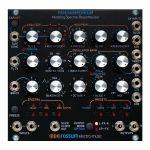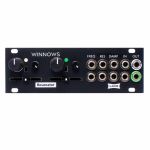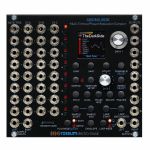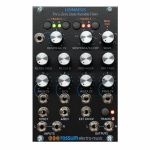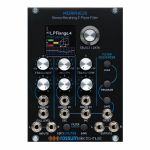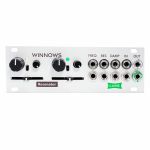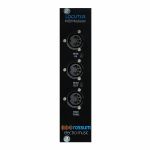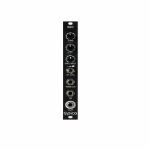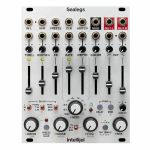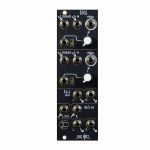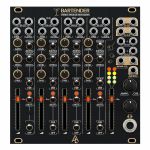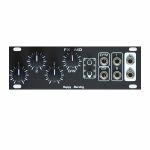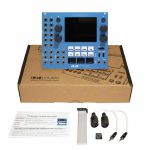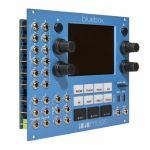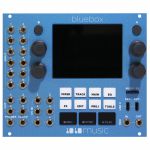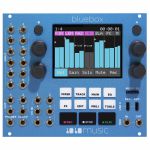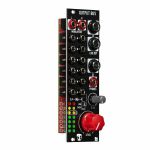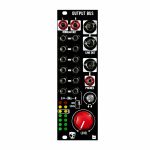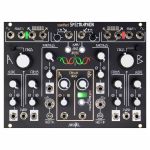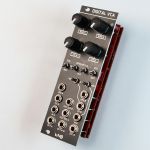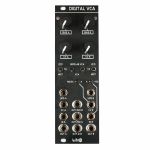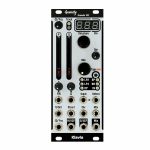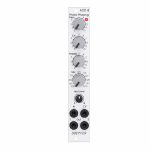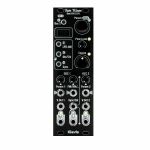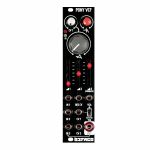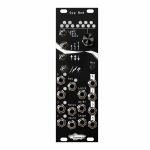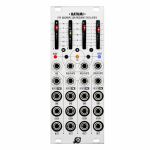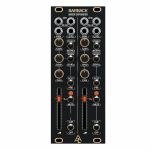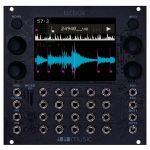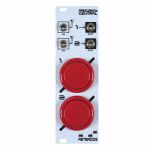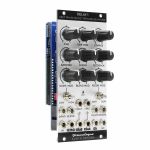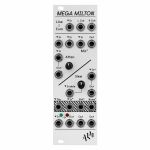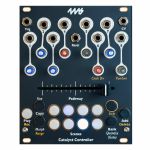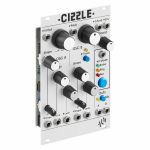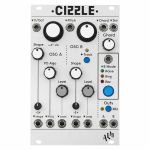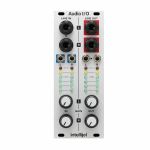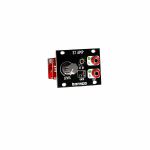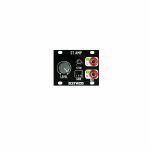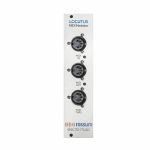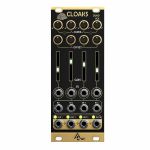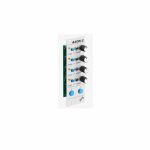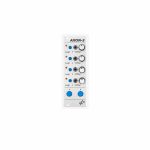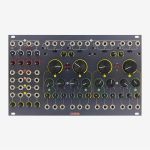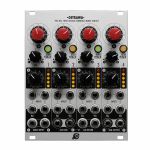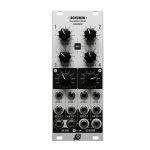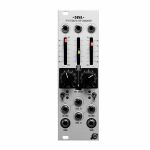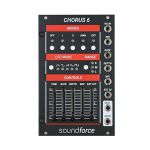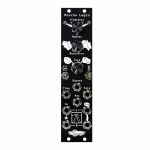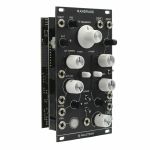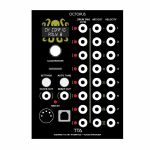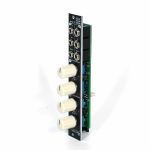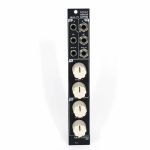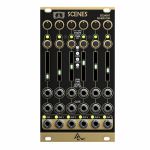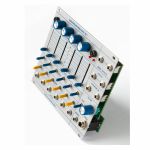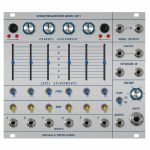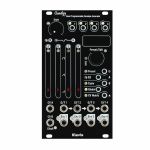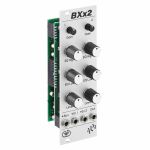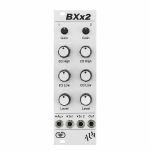100% Secure Shopping
Studio equipment
Our full range of studio equipment from all the leading equipment and software brands. Guaranteed fast delivery and low prices.
100% Secure Shopping
DJ equipment
Our full range of DJ equipment from all the leading equipment and software brands. Guaranteed fast delivery and low prices. Visit Juno DJ
Filter
Stock
Coming Soon
Equipment
Format
Release Date
Brand
Featured
Price
Tags
Rossum Electro-Music Panharmonium Mutating Spectral Resynthesiser Module (black) (oscillator/digital/clock generator/pitch shifter module)
Cat: 996371 Rel: 15 Apr 24
Mutating spectral resynthesiser module - 26HP
Notes: Rossum Electro-Music Software Architect Bob Bliss (who also, as it happens, fathered E-mu's famed "EOS" Emulator Operating System) has created Panharmonium, a unique music and sound design tool that lets you analyse the spectral content of any audio signal and use that analysis to drive a bank of from 1 to 33 oscillators. Depending on various control settings, Panharmonium can accurately reproduce the input spectrum in real time or modify it in a multitude of wildly creative ways. All with an interface whose immediacy encourages performance and interaction.
Panharmonium input can be anything from a single oscillator to an entire mix (including vocals). From dense, swirling pads and drones that evolve with the input's changing spectrum, to clock-syncable spectral arpeggiation, to as-yet unnamed harmonic effects, Panharmonium opens up an entirely new world of sonic possibilities.
Additionally, Panharmonium can take a snapshot of an instantaneous spectrum and use that as a complex harmonic oscillator, which can then be modified and modulated by all of Panharmonium's other controls.
Panharmonium accomplishes its magic though a combination of functional submodules:
Spectral Analyzer
The Spectral Analyzer provides tools for defining the analysis process.
- The Slice parameter sets the rate at which the incoming audio is transformed to spectral data. It can be set by the Slice and Multiplier controls, the Tap button, or by an external clock signal. Very short slice times result in real-time spectral data, while longer times can create rhythmic spectral patterns.
- The Center Freq and Bandwidth controls (and associated CV inputs and attenuverters) control the range of frequencies to be analysed. The Bandwidth control allows the selection of narrow to wide pass bands on the left side of the pot and narrow to wide notches on the right side of the pot. The ability to sweep the frequency and modify the bandwidth under CV control opens up a wide range of sonic effects.
- The Freeze button lets you freeze the spectral integrator, sustaining the currently analysed spectrum.
Spectral Modifiers
These controls allow you to creatively modify the analysed spectra.
- The Voice parameter lets you select from 1 to 33 oscillators to resynthesize the spectrum.
- The Blur parameter (and associated CV input) is a spectral lag processor that controls how quickly the spectrum can change.
- The Feedback control lets you route the resynthesized audio back into the entire processing chain for subtle or dramatic feedback effects. At its max, the output becomes self-sustaining, even if the input is removed.
Oscillator Bank
The Oscillator Bank resynthesizes the analysed spectra.
- The Waveform parameter selects the oscillators' waveform. In addition to the usual sine, triangle, sawtooth and pulse waveforms, two special crossfading sine and sawtooth waveforms are included.
- The Freq control lets you tune the oscillators over a +/-7 semitone range. The frequency is further controlled by the 1V/Oct input and the FM input and attenuverter.
- The Octave control, not surprisingly, shifts the pitch of the output by octaves.
- The Glide parameter sets the amount of polyphonic glide (i.e., each oscillator has its own glide circuit).
- The Mix control (and associated CV input) sets the balance between the original input audio and the resynthesized audio.
Optional Functions
A number of optional functions can be selected by using the Output Mode and Tap buttons.
- Holding the Output Mode button and adjusting the Slice control enables Drums Mode, which optimizes the spectral analysis for drums and other percussive inputs.
- Holding the Output Mode button and adjusting the Freq control enables Spectral Warping. In contrast to conventional frequency adjustment, where the harmonic relationships between the spectral elements are preserved, Spectral Warping shifts the harmonic elements individually, producing a variety of clangorous, swarming textures.
- Holding the Tap button and adjusting the Freq control quantizes the resulting frequency adjustments to semitones.
Spectra Memories and Presets
Panharmonium provides 12 user Spectra memories and 12 user Presets.
- The Spectra memories let you store up to 12 frozen slices. When selected, a spectrum (up to 33 oscillators wide!) replaces any live input and can have its pitch controlled by the 1V/Oct input and FM controls.
- A Preset is a snapshot of all of the module settings, along with the value of any CVs present at the moment the preset is saved.
Panharmonium is 26HP wide and 25mm deep.
Power requirements (max): 140mA +12V, 30mA -12V. Reverse polarity protected.
… Read morePanharmonium input can be anything from a single oscillator to an entire mix (including vocals). From dense, swirling pads and drones that evolve with the input's changing spectrum, to clock-syncable spectral arpeggiation, to as-yet unnamed harmonic effects, Panharmonium opens up an entirely new world of sonic possibilities.
Additionally, Panharmonium can take a snapshot of an instantaneous spectrum and use that as a complex harmonic oscillator, which can then be modified and modulated by all of Panharmonium's other controls.
Panharmonium accomplishes its magic though a combination of functional submodules:
Spectral Analyzer
The Spectral Analyzer provides tools for defining the analysis process.
- The Slice parameter sets the rate at which the incoming audio is transformed to spectral data. It can be set by the Slice and Multiplier controls, the Tap button, or by an external clock signal. Very short slice times result in real-time spectral data, while longer times can create rhythmic spectral patterns.
- The Center Freq and Bandwidth controls (and associated CV inputs and attenuverters) control the range of frequencies to be analysed. The Bandwidth control allows the selection of narrow to wide pass bands on the left side of the pot and narrow to wide notches on the right side of the pot. The ability to sweep the frequency and modify the bandwidth under CV control opens up a wide range of sonic effects.
- The Freeze button lets you freeze the spectral integrator, sustaining the currently analysed spectrum.
Spectral Modifiers
These controls allow you to creatively modify the analysed spectra.
- The Voice parameter lets you select from 1 to 33 oscillators to resynthesize the spectrum.
- The Blur parameter (and associated CV input) is a spectral lag processor that controls how quickly the spectrum can change.
- The Feedback control lets you route the resynthesized audio back into the entire processing chain for subtle or dramatic feedback effects. At its max, the output becomes self-sustaining, even if the input is removed.
Oscillator Bank
The Oscillator Bank resynthesizes the analysed spectra.
- The Waveform parameter selects the oscillators' waveform. In addition to the usual sine, triangle, sawtooth and pulse waveforms, two special crossfading sine and sawtooth waveforms are included.
- The Freq control lets you tune the oscillators over a +/-7 semitone range. The frequency is further controlled by the 1V/Oct input and the FM input and attenuverter.
- The Octave control, not surprisingly, shifts the pitch of the output by octaves.
- The Glide parameter sets the amount of polyphonic glide (i.e., each oscillator has its own glide circuit).
- The Mix control (and associated CV input) sets the balance between the original input audio and the resynthesized audio.
Optional Functions
A number of optional functions can be selected by using the Output Mode and Tap buttons.
- Holding the Output Mode button and adjusting the Slice control enables Drums Mode, which optimizes the spectral analysis for drums and other percussive inputs.
- Holding the Output Mode button and adjusting the Freq control enables Spectral Warping. In contrast to conventional frequency adjustment, where the harmonic relationships between the spectral elements are preserved, Spectral Warping shifts the harmonic elements individually, producing a variety of clangorous, swarming textures.
- Holding the Tap button and adjusting the Freq control quantizes the resulting frequency adjustments to semitones.
Spectra Memories and Presets
Panharmonium provides 12 user Spectra memories and 12 user Presets.
- The Spectra memories let you store up to 12 frozen slices. When selected, a spectrum (up to 33 oscillators wide!) replaces any live input and can have its pitch controlled by the 1V/Oct input and FM controls.
- A Preset is a snapshot of all of the module settings, along with the value of any CVs present at the moment the preset is saved.
Panharmonium is 26HP wide and 25mm deep.
Power requirements (max): 140mA +12V, 30mA -12V. Reverse polarity protected.
out of stock $580.14
Laine Winnows 1U Dual VC Resonator Module (black) (resonator/dual/stereo/filter/oscillator module)
Cat: 1008011 Rel: 17 Apr 24
Dual voltage controlled resonator 1U module - 24HP
Notes: Winnows, a dual VC resonant filter with damping.
Winnows brings radical resonant filtering to the 1U row. Make your basslines growl like it's 1999. Create clean resonant tones and layers, tuned percussion, steep filtered peaks, vowel filters and more. Each filter channel comprises two state variable filter cores, the first producing a 2-Pole band-pass response, with resonance and self-oscillation amounts set by a 3-Pole feedback network. Signals are then routed through a 1-Pole low-pass damping stage to remove harshness if required. This can be routed to the channel output, or switched and routed through a second series of resonant SVF and 1-Pole LPF damping stages. This circuitry is identical per channel.
Features and uses
Steep and spiked or wide and smooth, resonant bandpass filters
Zone in on and reinforce a sound's dominant frequency, create overtones using both channels
Create sharp resonant peaks, dull or remove any harshness with VC damping
Use the resonator as a sound source by shaping and triggering tuned percussion tones or kick drums
Per channel: 2 x VCA based SVF, 2 x 1-pole damping LPF, 1 x 3-Pole resonance core
Identical circuitry per channel, CV and audio jacks are normalled between channels
Combine both channels in series for vowel filter responses and creative filtering
Specifications
Intellijel 1U format
Width 24 HP
Depth 34mm
Power requirements ~90mA +12V/~80mA -12V
Control voltage range 0-8V
Impedance Input 100K / Output 1K
… Read moreWinnows brings radical resonant filtering to the 1U row. Make your basslines growl like it's 1999. Create clean resonant tones and layers, tuned percussion, steep filtered peaks, vowel filters and more. Each filter channel comprises two state variable filter cores, the first producing a 2-Pole band-pass response, with resonance and self-oscillation amounts set by a 3-Pole feedback network. Signals are then routed through a 1-Pole low-pass damping stage to remove harshness if required. This can be routed to the channel output, or switched and routed through a second series of resonant SVF and 1-Pole LPF damping stages. This circuitry is identical per channel.
Features and uses
Steep and spiked or wide and smooth, resonant bandpass filters
Zone in on and reinforce a sound's dominant frequency, create overtones using both channels
Create sharp resonant peaks, dull or remove any harshness with VC damping
Use the resonator as a sound source by shaping and triggering tuned percussion tones or kick drums
Per channel: 2 x VCA based SVF, 2 x 1-pole damping LPF, 1 x 3-Pole resonance core
Identical circuitry per channel, CV and audio jacks are normalled between channels
Combine both channels in series for vowel filter responses and creative filtering
Specifications
Intellijel 1U format
Width 24 HP
Depth 34mm
Power requirements ~90mA +12V/~80mA -12V
Control voltage range 0-8V
Impedance Input 100K / Output 1K
out of stock $192.51
Rossum Electro-Music Assimil8or Multi-Timbral Phase Modulation Sampler Module (black) (sampling/CV modulation/digital/drum/dual/stereo/multiple/LFO module)
Cat: 996331 Rel: 15 Apr 24
multi-timbral phase modulation sampler module - 28HP
Notes: Sampler legend Dave Rossum's ultra-powerful Assimil8or module gets a black makeover. Eight-channel multi-timbral design with extensive CV control and clever sound manipulation options.
Supplier's Notes:
Designed to provide a powerful, flexible sampling engine for modular synthesis, the ASSIMIL8OR Multi-Timbral Phase Modulation Sampler module is the latest incarnation of Dave Rossum's decades-long pioneering of affordable professional sampling technology.
ASSIMIL8OR provides eight independent channels of sampling with sound quality that can range from extremely hi-fi to low fi, all with extensive real-time CV control.
Assimil8or Specifications
Sample memory
2,300 seconds at 48kHz mono, freely allocatable between the 8 channels
Sample rates
48kHZ, 96kHZ, 192kHZ
A/D & D/A
24 Bits
Internal processing
32 Bits
Latency
100 microseconds at the Mix Outputs
180 microseconds at the Individual Outputs
Inputs
Sample L/R
2x 3.5mm mono socket
100kO Input Impedance
Gate/Trigger 1-8
8x 3.5mm mono socket
100kO Input Impedance
1.6V threshold
Control Voltage A 1-8
8x 3.5mm mono socket
100kO Input Impedance
96 kHz sample rate
Anti-alias filtered to 20kHz bandwidth
Control Voltage B&C 1-8
16x 3.5mm mono socket
100kO Input Impedance
48 kHz sample rate
No anti-alias filtering
Outputs
Mix Outputs L/R
2x 3.5mm mono socket
1kO Impedance
Individual Outputs
8x 3.5mm mono socket
1kO Impedance
Power requirements: +/-12V via 16-pin, Doepfer-style connector
Current draw: 220mA +12V, 30mA -12V
Dimensions: 28HP (W); Panel to power connector (with connector plugged in) 25mm (D)
Supplied accessories:
1x Micro SD card
1x 16-pin, Doepfer-style cable
4x M3 screws
4x M2.5 screws
4x Nylon washers
1x Quickstart Guide
… Read moreSupplier's Notes:
Designed to provide a powerful, flexible sampling engine for modular synthesis, the ASSIMIL8OR Multi-Timbral Phase Modulation Sampler module is the latest incarnation of Dave Rossum's decades-long pioneering of affordable professional sampling technology.
ASSIMIL8OR provides eight independent channels of sampling with sound quality that can range from extremely hi-fi to low fi, all with extensive real-time CV control.
Assimil8or Specifications
Sample memory
2,300 seconds at 48kHz mono, freely allocatable between the 8 channels
Sample rates
48kHZ, 96kHZ, 192kHZ
A/D & D/A
24 Bits
Internal processing
32 Bits
Latency
100 microseconds at the Mix Outputs
180 microseconds at the Individual Outputs
Inputs
Sample L/R
2x 3.5mm mono socket
100kO Input Impedance
Gate/Trigger 1-8
8x 3.5mm mono socket
100kO Input Impedance
1.6V threshold
Control Voltage A 1-8
8x 3.5mm mono socket
100kO Input Impedance
96 kHz sample rate
Anti-alias filtered to 20kHz bandwidth
Control Voltage B&C 1-8
16x 3.5mm mono socket
100kO Input Impedance
48 kHz sample rate
No anti-alias filtering
Outputs
Mix Outputs L/R
2x 3.5mm mono socket
1kO Impedance
Individual Outputs
8x 3.5mm mono socket
1kO Impedance
Power requirements: +/-12V via 16-pin, Doepfer-style connector
Current draw: 220mA +12V, 30mA -12V
Dimensions: 28HP (W); Panel to power connector (with connector plugged in) 25mm (D)
Supplied accessories:
1x Micro SD card
1x 16-pin, Doepfer-style cable
4x M3 screws
4x M2.5 screws
4x Nylon washers
1x Quickstart Guide
1 in stock $970.38
Click for better price!
or call +44 20 7424 1960
quote 996331
quote 996331
Rossum Electro-Music Linnaeus Stereo Thru-Zero State Variable Filter Module (black) (modular synthesiser)
Cat: 996358 Rel: 15 Apr 24
Stereo thru-zero state variable filter module - 16HP
Notes: Following in the tradition of Evolution and Morpheus, LINNAEUS represents yet another Dave Rossum innovation in filter technology.
LINNAEUS is a stereo state variable filter that provides the unique ability to linearly modulate its resonant frequency through zero into negative frequency, while maintaining stability. With extensive voltage control of nearly every parameter, Linnaeus lets you manipulate the filter's natural response curve in new ways, to create both subtle and dramatic timbral effects. And with a "one-knob-per-parameter" interface, LINNAEUS inspires sonic creativity that invites (and rewards) real-time interaction.
LINNAEUS's cutoff/resonant frequency is exponentially voltage controllable from sub-audio to ultrasonic frequencies, while its resonant gain (Q) is exponentially voltage controllable from 0dB to greater than 60dB.
LINNAEUS's channel output response characteristics are independently and continuously variable from Lowpass, through Bandpass, Highpass and Notch, to Low and High Shelving characteristics. Voltage control of the response characteristics are independently selectable for each of the two channels.
The linear thru-zero modulation is provided by an integrated modulation oscillator and/or an External Linear FM modulation input.
The voltage-controllable modulation oscillator can track the filter's exponential frequency or operate independently. The modulation oscillator's output waveform is continuously variable from Off through Sine, Triangle, and Sawtooth, to Square. The modulation oscillator output is summed with the external linear FM input and applied to the modulation index VCA, which controls the linear thru-zero modulation index from zero to 8X. The modulation index is, of course, also voltage controllable.
LINNAEUS features include:
- Ultra-wide frequency range, exponentially voltage-controllable from sub-audio to ultrasonic via precise 1V/OCT and attenuverted CV inputs.
- Thru-zero linear frequency modulation via an internal modulation oscillator and/or an external linear FM input.
- Variable linear modulation index, voltage-controllable via an attenuverted CV input.
- Resonance (Q) exponentially voltage-controllable from 0dB to greater than 60dB via 6dB/V and attenuverted CV inputs.
- Continuously variable response characteristics independently selectable for each of the two channels via individual Response Enable controls. Characteristics include Lowpass (12db/oct and 6db/oct), Bandpass, Highpass (12db/oct and 6db/oct), Notch, and Low and High Shelving.
- Voltage control of response characteristics via an attenuverted CV input. Individual Response CV Enable controls let you independently enable or disable CV control of response for each channel.
- An integrated modulation oscillator with continuously variable waveform from Off through Sine, Triangle, Sawtooth and Square. Its frequency can be exponentially voltage controlled via an attenuverted CV input.
- A Track control that lets the modulation oscillator precisely track the filter's exponential frequency.
- Stereo inputs and outputs. LINNAEUS can process a stereo signal or two independent mono signals. While the two channels share the filter's cutoff/resonant frequency, the filter response characteristics can be independently controlled for each channel.
- The solid, high-quality construction you expect from Rossum Electro-Music.
What's with the egg?
The functional description above describes LINNAEUS as originally conceived and designed by Dave. However, late in the beta testing process, Rossum's tester, Chris Meyer, raised the possibility of alternative behavior that would let LINNAEUS function as a self-contained (i.e., no input required) stereo oscillator and/or FM percussion voice with some really powerful timbral capabilities.
While Rossum were initially hesitant to try to shoehorn the new functions into the existing interface, once Dave had prototyped them, it was clear to us all that they were just too cool not to include. So, Rossum have provided them in the form of alternate firmware accessed by pressing and holding the Egg button.
LINNAEUS is 16HP wide and 25mm deep.
Power requirements (max): 155mA +12V, 36mA -12V. Reverse polarity protected.
… Read moreLINNAEUS is a stereo state variable filter that provides the unique ability to linearly modulate its resonant frequency through zero into negative frequency, while maintaining stability. With extensive voltage control of nearly every parameter, Linnaeus lets you manipulate the filter's natural response curve in new ways, to create both subtle and dramatic timbral effects. And with a "one-knob-per-parameter" interface, LINNAEUS inspires sonic creativity that invites (and rewards) real-time interaction.
LINNAEUS's cutoff/resonant frequency is exponentially voltage controllable from sub-audio to ultrasonic frequencies, while its resonant gain (Q) is exponentially voltage controllable from 0dB to greater than 60dB.
LINNAEUS's channel output response characteristics are independently and continuously variable from Lowpass, through Bandpass, Highpass and Notch, to Low and High Shelving characteristics. Voltage control of the response characteristics are independently selectable for each of the two channels.
The linear thru-zero modulation is provided by an integrated modulation oscillator and/or an External Linear FM modulation input.
The voltage-controllable modulation oscillator can track the filter's exponential frequency or operate independently. The modulation oscillator's output waveform is continuously variable from Off through Sine, Triangle, and Sawtooth, to Square. The modulation oscillator output is summed with the external linear FM input and applied to the modulation index VCA, which controls the linear thru-zero modulation index from zero to 8X. The modulation index is, of course, also voltage controllable.
LINNAEUS features include:
- Ultra-wide frequency range, exponentially voltage-controllable from sub-audio to ultrasonic via precise 1V/OCT and attenuverted CV inputs.
- Thru-zero linear frequency modulation via an internal modulation oscillator and/or an external linear FM input.
- Variable linear modulation index, voltage-controllable via an attenuverted CV input.
- Resonance (Q) exponentially voltage-controllable from 0dB to greater than 60dB via 6dB/V and attenuverted CV inputs.
- Continuously variable response characteristics independently selectable for each of the two channels via individual Response Enable controls. Characteristics include Lowpass (12db/oct and 6db/oct), Bandpass, Highpass (12db/oct and 6db/oct), Notch, and Low and High Shelving.
- Voltage control of response characteristics via an attenuverted CV input. Individual Response CV Enable controls let you independently enable or disable CV control of response for each channel.
- An integrated modulation oscillator with continuously variable waveform from Off through Sine, Triangle, Sawtooth and Square. Its frequency can be exponentially voltage controlled via an attenuverted CV input.
- A Track control that lets the modulation oscillator precisely track the filter's exponential frequency.
- Stereo inputs and outputs. LINNAEUS can process a stereo signal or two independent mono signals. While the two channels share the filter's cutoff/resonant frequency, the filter response characteristics can be independently controlled for each channel.
- The solid, high-quality construction you expect from Rossum Electro-Music.
What's with the egg?
The functional description above describes LINNAEUS as originally conceived and designed by Dave. However, late in the beta testing process, Rossum's tester, Chris Meyer, raised the possibility of alternative behavior that would let LINNAEUS function as a self-contained (i.e., no input required) stereo oscillator and/or FM percussion voice with some really powerful timbral capabilities.
While Rossum were initially hesitant to try to shoehorn the new functions into the existing interface, once Dave had prototyped them, it was clear to us all that they were just too cool not to include. So, Rossum have provided them in the form of alternate firmware accessed by pressing and holding the Egg button.
LINNAEUS is 16HP wide and 25mm deep.
Power requirements (max): 155mA +12V, 36mA -12V. Reverse polarity protected.
1 in stock $485.69
Click for better price!
or call +44 20 7424 1960
quote 996358
quote 996358
Rossum Electro-Music Morpheus Stereo Morphing Z-Plane Filter Module (black) (filter/sequencer/dual/stereo/effect module)
Cat: 996369 Rel: 15 Apr 24
Stereo morphing z-plane filter module - 18HP
Notes: With the MORPHEUS digital filter module, Rossum are finally able to unleash the full power of the 14-pole Z0-Plane Filters that Dave invented for the E-mu Morpheus synthesizer.
The MORPHEUS Eurorack module includes over 280 filter configurations, which are called Cubes. Each Cube is composed of up to 8 complex filters that you can picture as being at the corners of a three dimensional cube (hence the name). Morpheus gives you the ability to smoothly interpolate between those 8 filters within the cube's three dimensional space.
Due to processor limitations back in the day, the original Morpheus was capable of real-time morphing in one dimension, but interpolation in the frequency and transform dimensions were set at note-on and remained static for the remainder of the note. But even with that limitation, Morpheus offered sonic capabilities that are unmatched to this day.
With the MORPHEUS filter module, you now have simultaneous real-time CV control of all three dimensions, for dynamic timbral effects unlike anything you've ever heard before. In stereo.
Like all Rossum Electro-Music digital modules, all parameters are available for adjustment with a single button press. No menu diving.
Morpheus Specifications
Filter cubes: 289
Filters: 1000
Filter sequences: 200
Sequence steps: 20,000 Dynamically Allocated
Inputs: Audio L/R
2x 3.5mm mono socket
100kO Input Impedance
Full Level Frequency CV
1x 3.5mm mono socket
100kO Input Impedance
Attenuverted Frequency CV
1x 3.5mm mono socket
100kO Input Impedance
Attenuverted Morph CV
1x 3.5mm mono socket
100kO Input Impedance
Attenuverted Transform/Distortion CV
1x 3.5mm mono socket
100kO Input Impedance
Filter Sequencer Dec
1x 3.5mm mono socket
100kO Input Impedance
1.6V threshold
Filter Sequencer Inc
1x 3.5mm mono socket
100kO Input Impedance
1.6V threshold
Filter Sequencer Reset
1x 3.5mm mono socket
100kO Input Impedance
1.6V threshold
Outputs
Audio L/R
2x 3.5mm mono socket
1kO Impedance
Power requirements
+/-12V via 16-pin, Doepfer-style connector
Current draw
135mA +12V, 25mA -12V (maximum)
Dimensions
18HP (W); Panel to power connector (with connector plugged in) 25mm (D)
Supplied accessories
1x 16-pin, Doepfer-style cable
4x M3 screws
4x M2.5 screws
4x Nylon washers
1x Quickstart Guide
… Read moreThe MORPHEUS Eurorack module includes over 280 filter configurations, which are called Cubes. Each Cube is composed of up to 8 complex filters that you can picture as being at the corners of a three dimensional cube (hence the name). Morpheus gives you the ability to smoothly interpolate between those 8 filters within the cube's three dimensional space.
Due to processor limitations back in the day, the original Morpheus was capable of real-time morphing in one dimension, but interpolation in the frequency and transform dimensions were set at note-on and remained static for the remainder of the note. But even with that limitation, Morpheus offered sonic capabilities that are unmatched to this day.
With the MORPHEUS filter module, you now have simultaneous real-time CV control of all three dimensions, for dynamic timbral effects unlike anything you've ever heard before. In stereo.
Like all Rossum Electro-Music digital modules, all parameters are available for adjustment with a single button press. No menu diving.
Morpheus Specifications
Filter cubes: 289
Filters: 1000
Filter sequences: 200
Sequence steps: 20,000 Dynamically Allocated
Inputs: Audio L/R
2x 3.5mm mono socket
100kO Input Impedance
Full Level Frequency CV
1x 3.5mm mono socket
100kO Input Impedance
Attenuverted Frequency CV
1x 3.5mm mono socket
100kO Input Impedance
Attenuverted Morph CV
1x 3.5mm mono socket
100kO Input Impedance
Attenuverted Transform/Distortion CV
1x 3.5mm mono socket
100kO Input Impedance
Filter Sequencer Dec
1x 3.5mm mono socket
100kO Input Impedance
1.6V threshold
Filter Sequencer Inc
1x 3.5mm mono socket
100kO Input Impedance
1.6V threshold
Filter Sequencer Reset
1x 3.5mm mono socket
100kO Input Impedance
1.6V threshold
Outputs
Audio L/R
2x 3.5mm mono socket
1kO Impedance
Power requirements
+/-12V via 16-pin, Doepfer-style connector
Current draw
135mA +12V, 25mA -12V (maximum)
Dimensions
18HP (W); Panel to power connector (with connector plugged in) 25mm (D)
Supplied accessories
1x 16-pin, Doepfer-style cable
4x M3 screws
4x M2.5 screws
4x Nylon washers
1x Quickstart Guide
1 in stock $580.36
Laine Winnows 1U Dual VC Resonator Module (silver) (resonator/dual/stereo/filter/oscillator module)
Cat: 1008005 Rel: 17 Apr 24
Dual voltage controlled resonator 1U module - 24HP
Notes: Winnows, a dual VC resonant filter with damping.
Winnows brings radical resonant filtering to the 1U row. Make your basslines growl like it's 1999. Create clean resonant tones and layers, tuned percussion, steep filtered peaks, vowel filters and more. Each filter channel comprises two state variable filter cores, the first producing a 2-Pole band-pass response, with resonance and self-oscillation amounts set by a 3-Pole feedback network. Signals are then routed through a 1-Pole low-pass damping stage to remove harshness if required. This can be routed to the channel output, or switched and routed through a second series of resonant SVF and 1-Pole LPF damping stages. This circuitry is identical per channel.
Features and uses
Steep and spiked or wide and smooth, resonant bandpass filters
Zone in on and reinforce a sound's dominant frequency, create overtones using both channels
Create sharp resonant peaks, dull or remove any harshness with VC damping
Use the resonator as a sound source by shaping and triggering tuned percussion tones or kick drums
Per channel: 2 x VCA based SVF, 2 x 1-pole damping LPF, 1 x 3-Pole resonance core
Identical circuitry per channel, CV and audio jacks are normalled between channels
Combine both channels in series for vowel filter responses and creative filtering
Specifications
Intellijel 1U format
Width 24 HP
Depth 34mm
Power requirements ~90mA +12V/~80mA -12V
Control voltage range 0-8V
Impedance Input 100K / Output 1K
… Read moreWinnows brings radical resonant filtering to the 1U row. Make your basslines growl like it's 1999. Create clean resonant tones and layers, tuned percussion, steep filtered peaks, vowel filters and more. Each filter channel comprises two state variable filter cores, the first producing a 2-Pole band-pass response, with resonance and self-oscillation amounts set by a 3-Pole feedback network. Signals are then routed through a 1-Pole low-pass damping stage to remove harshness if required. This can be routed to the channel output, or switched and routed through a second series of resonant SVF and 1-Pole LPF damping stages. This circuitry is identical per channel.
Features and uses
Steep and spiked or wide and smooth, resonant bandpass filters
Zone in on and reinforce a sound's dominant frequency, create overtones using both channels
Create sharp resonant peaks, dull or remove any harshness with VC damping
Use the resonator as a sound source by shaping and triggering tuned percussion tones or kick drums
Per channel: 2 x VCA based SVF, 2 x 1-pole damping LPF, 1 x 3-Pole resonance core
Identical circuitry per channel, CV and audio jacks are normalled between channels
Combine both channels in series for vowel filter responses and creative filtering
Specifications
Intellijel 1U format
Width 24 HP
Depth 34mm
Power requirements ~90mA +12V/~80mA -12V
Control voltage range 0-8V
Impedance Input 100K / Output 1K
1 in stock $192.51
Click for better price!
or call +44 20 7424 1960
quote 1008005
quote 1008005
Rossum Electro-Music Locutus MIDI Mediator Module For Assimil8or (black) (expander/MIDI/utility module)
Cat: 996361 Rel: 15 Apr 24
MIDI mediator module for Assimil8or - 6HP
Notes: LOCUTUS is designed to interface Assimil8or with MIDI instruments, controllers, and sequencers to provide multichannel modulation and new polyphonic possibilities.
LOCUTUS includes a special attached cable to connect to the Assimil8or CPU behind the panel.
LOCUTUS is 6 HP wide and 25mm deep.
MIDI sources connected to LOCUTUS’ MIDI IN port can be used to modulate Assimil8or parameters using velocity, channel pressure, and MIDI CC (Continuous Controller) messages, select presets using MIDI Program Change (PC) messages, and/or optionally trigger Assimil8or channels with MIDI notes using user-selectable assignment modes. MIDI Setups can be configured with assignment modes including Dynamic, which intelligently cycles through Assimil8or’s channels to easily create polyphonic patches, Multi assignment modes ideal for playing multitimbral Assimil8or patches with MIDI sequencers, SP-1200 modes designed especially for triggering Assimil8or with SP-1200’s MIDI output, and more.
Locutus’ MIDI OUT port can be used to optionally transmit program messages when presets are changed and/or to send MIDI CC data based on the analog control voltages patched to Assimil8or’s 24 CV inputs. Using the new CV-to-MIDI options, Assimil8or and Locutus can be configured to control and modulate MIDI equipment using a eurorack modular system.
… Read moreLOCUTUS includes a special attached cable to connect to the Assimil8or CPU behind the panel.
LOCUTUS is 6 HP wide and 25mm deep.
MIDI sources connected to LOCUTUS’ MIDI IN port can be used to modulate Assimil8or parameters using velocity, channel pressure, and MIDI CC (Continuous Controller) messages, select presets using MIDI Program Change (PC) messages, and/or optionally trigger Assimil8or channels with MIDI notes using user-selectable assignment modes. MIDI Setups can be configured with assignment modes including Dynamic, which intelligently cycles through Assimil8or’s channels to easily create polyphonic patches, Multi assignment modes ideal for playing multitimbral Assimil8or patches with MIDI sequencers, SP-1200 modes designed especially for triggering Assimil8or with SP-1200’s MIDI output, and more.
Locutus’ MIDI OUT port can be used to optionally transmit program messages when presets are changed and/or to send MIDI CC data based on the analog control voltages patched to Assimil8or’s 24 CV inputs. Using the new CV-to-MIDI options, Assimil8or and Locutus can be configured to control and modulate MIDI equipment using a eurorack modular system.
1 in stock $226.24
Click for better price!
or call +44 20 7424 1960
quote 996361
quote 996361
Cat: 1014286 Rel: 01 Jan 90
B-STOCK: Without original box, product in perfect working order
Notes: ***B-STOCK: Without original box, product in perfect working order***
Pico BBD is surprisingly great sounding (we were surprised ourselves), full analogue 4092 stage bucket brigade delay module; the smallest BBD in Eurorack. Besides nice and clean flanger and delay effects, at full CW settings of TIME and feedback knobs it can produce extreme sonic artefacts. Tweak knobs and enjoy!
… Read morePico BBD is surprisingly great sounding (we were surprised ourselves), full analogue 4092 stage bucket brigade delay module; the smallest BBD in Eurorack. Besides nice and clean flanger and delay effects, at full CW settings of TIME and feedback knobs it can produce extreme sonic artefacts. Tweak knobs and enjoy!
out of stock $85.81
Intellijel Sealegs Multi-Mode Stereo Character Delay Module With Reverb (dual/stereo/delay/reverb synth module)
Cat: 966771 Rel: 08 Sep 23
Multi-mode stereo character delay module with reverb - 20HP.
Notes: Multi-model stereo delay with reverb, featuring tape, bucket brigade and crossfading digital models, plus saturation, filters, internal modulation plus tons of CV control. Vibey as hell.
Supplier's Notes:
It's all gone a bit wobbly
Intellijel's design goal for Sealegs was to create the warmest, most musical and organic delay module possible - something that would sweeten and enhance any audio one chose to feed into it. As such, great care has gone into modelling the most distinctive and desirable sonic characteristics of three different types of delay circuits: Tape; Bucket Brigade, and Crossfading Digital.
A plethora of onboard controls enable you to dial in exactly the sound you want; synced or un-synced delays times (for both left and right channels); a built-in modulator with seven morphing waveshapes, a Wow & Flutter emulation, and an envelope follower; plus dedicated low- and high-pass filters; built-in hiss & crackle noises; per-model colour controls; a spacious reverb; and a re-configurable signal flow through the unit. In addition, attenuverted modulation inputs abound - ensuring the delay ebbs and flows with your musical needs.
Features
Three Unique delay models with per-model "Color", modulation behaviour, and saturation/limiting
Three Stereo configurations (PONG, L/R, Time/Width)
Built-in modulator with multiple, morphing wave shapes
Lush, routable 1970s-inspired reverb
Noise control to introduce hiss and crackle.
Highpass and lowpass filters for filtered repeats
Input drive with level trim
Per-model Freeze functionality for holding the delay contents and looping
Delay times up to 6 sec (L channel) and 8 sec (R channel, Width adds 33% to Time)
9 CV inputs (with attenuverters)
Stable external clock syncing (or tap tempo)
96 kHz, 32-bit stereo floating point processing
Size: 20HP
Depth: 29mm
Power: 116mA @ +12V 10mA @ -12V
… Read moreSupplier's Notes:
It's all gone a bit wobbly
Intellijel's design goal for Sealegs was to create the warmest, most musical and organic delay module possible - something that would sweeten and enhance any audio one chose to feed into it. As such, great care has gone into modelling the most distinctive and desirable sonic characteristics of three different types of delay circuits: Tape; Bucket Brigade, and Crossfading Digital.
A plethora of onboard controls enable you to dial in exactly the sound you want; synced or un-synced delays times (for both left and right channels); a built-in modulator with seven morphing waveshapes, a Wow & Flutter emulation, and an envelope follower; plus dedicated low- and high-pass filters; built-in hiss & crackle noises; per-model colour controls; a spacious reverb; and a re-configurable signal flow through the unit. In addition, attenuverted modulation inputs abound - ensuring the delay ebbs and flows with your musical needs.
Features
Three Unique delay models with per-model "Color", modulation behaviour, and saturation/limiting
Three Stereo configurations (PONG, L/R, Time/Width)
Built-in modulator with multiple, morphing wave shapes
Lush, routable 1970s-inspired reverb
Noise control to introduce hiss and crackle.
Highpass and lowpass filters for filtered repeats
Input drive with level trim
Per-model Freeze functionality for holding the delay contents and looping
Delay times up to 6 sec (L channel) and 8 sec (R channel, Width adds 33% to Time)
9 CV inputs (with attenuverters)
Stable external clock syncing (or tap tempo)
96 kHz, 32-bit stereo floating point processing
Size: 20HP
Depth: 29mm
Power: 116mA @ +12V 10mA @ -12V
7 in stock $412.02
Make Noise DXG Dual Stereo Low Pass Gate & Mixer Module (dual/strereo/low pass gate/mixer module)
Cat: 992443 Rel: 29 Jan 24
Dual stereo low pass gate & mixer module - 8HP
Notes: The Dual Stereo Gate (DXG) music synthesizer module is a Dual Stereo Low Pass Gate and Mixer. It follows in the footsteps of the QMMG, Optomix, RxMx, DynaMix, and LxD. Unlike its predecessors, the DXG is specifically oriented around mixing stereo signals, making it an important addition to any system containing modules like XPO, QPAS, Morphagene, Mimeophon, and other stereo modules by Make Noise or others.
Unique to the DXG is a new low pass gate circuit that does not use vactrols. This circuit is 100% analogue and its response was arrived at after many months tailoring it to meet or exceed the expectations that have been set by all the vactrol low pass gates that Make Noise has created over the years.
In the past, Make Noise produced the Dynamix module and Dynamics circuit in the 0-COAST, both of which are vactrolless LPGs; however, the DXG is a completely new approach which better implements the gentle single pole filtering of a low pass gate, while also emulating the slow decay and memory of the vactrol based low pass gate. This new circuit makes possible the consistency of response necessary for versatile stereo use, while also keeping the module small and affordable so that it can be a key part of just about any modular system.
As on all of Make Noise's low pass gates, the DXG's Control parameter is used to set both the amplitude and the frequency content of the sound that passes through it. The control parameter tends to open faster than it closes, imparting a subtle decay phase onto any envelope shape that is used to modulate it.
Unlike previous low pass gates made by Make Noise, all the DXG's inputs and outputs are stereo. Each set of inputs is normalled so that the left input can be used for a mono signal, sending a copy to both left and right outputs. The Auxiliary inputs are also a stereo pair with mono normalization. These normalizations allow for the DXG to be used as a simple three channel stereo mixer, with one or two of the channels additionally being used for dynamics control and note event generation. The Aux inputs can be used to chain together larger decentralized mixes using additional DXG modules, or X-PAN, Optomix, modDemix etc.
Features
- Make Noise's first Stereo Low Pass Gate
- Vactrol-free design for classic Low Pass Gate sounds, but with the balance and consistency needed for true Stereo
- Fully Stereo i/o for easy integration into a Stereo-equipped modular synthesizer
- All Left inputs normalled for easy use with Mono signals
- STRIKE Input allows use of Gate signal to trigger Low Pass Gate circuit, creating "plucking" or "pinging" sound from any Gate
- Summing stage with Stereo AUXiliary IN allows for chaining of multiple units, creating larger mixes
- Part of a decentralized mix console integrated throughout the system along with X-PAN, Optomix, XOH, etc.
- Pairs well with XPO, QPAS, Morphagene, Mimeophon, Spectraphon etc.
Width: 8hp
Power:
74mA @ +12V
86mA @ -12V
Module Depth (incl power cable): 43mm
… Read moreUnique to the DXG is a new low pass gate circuit that does not use vactrols. This circuit is 100% analogue and its response was arrived at after many months tailoring it to meet or exceed the expectations that have been set by all the vactrol low pass gates that Make Noise has created over the years.
In the past, Make Noise produced the Dynamix module and Dynamics circuit in the 0-COAST, both of which are vactrolless LPGs; however, the DXG is a completely new approach which better implements the gentle single pole filtering of a low pass gate, while also emulating the slow decay and memory of the vactrol based low pass gate. This new circuit makes possible the consistency of response necessary for versatile stereo use, while also keeping the module small and affordable so that it can be a key part of just about any modular system.
As on all of Make Noise's low pass gates, the DXG's Control parameter is used to set both the amplitude and the frequency content of the sound that passes through it. The control parameter tends to open faster than it closes, imparting a subtle decay phase onto any envelope shape that is used to modulate it.
Unlike previous low pass gates made by Make Noise, all the DXG's inputs and outputs are stereo. Each set of inputs is normalled so that the left input can be used for a mono signal, sending a copy to both left and right outputs. The Auxiliary inputs are also a stereo pair with mono normalization. These normalizations allow for the DXG to be used as a simple three channel stereo mixer, with one or two of the channels additionally being used for dynamics control and note event generation. The Aux inputs can be used to chain together larger decentralized mixes using additional DXG modules, or X-PAN, Optomix, modDemix etc.
Features
- Make Noise's first Stereo Low Pass Gate
- Vactrol-free design for classic Low Pass Gate sounds, but with the balance and consistency needed for true Stereo
- Fully Stereo i/o for easy integration into a Stereo-equipped modular synthesizer
- All Left inputs normalled for easy use with Mono signals
- STRIKE Input allows use of Gate signal to trigger Low Pass Gate circuit, creating "plucking" or "pinging" sound from any Gate
- Summing stage with Stereo AUXiliary IN allows for chaining of multiple units, creating larger mixes
- Part of a decentralized mix console integrated throughout the system along with X-PAN, Optomix, XOH, etc.
- Pairs well with XPO, QPAS, Morphagene, Mimeophon, Spectraphon etc.
Width: 8hp
Power:
74mA @ +12V
86mA @ -12V
Module Depth (incl power cable): 43mm
3 in stock $205.48
Click for better price!
or call +44 20 7424 1960
quote 992443
quote 992443
After Later Audio Bartender Stereo Performance Mixer Module (mixer/dual/stereo/panning/VCA module)
Cat: 1004400 Rel: 11 Mar 24
4-channel stereo production mixer module - 24HP
Notes: Neatly implemented performance mixer with four stereo channels. CV control of level and pan, two pre- or post-fader stereo send busses, quiet mutes and cueing via a front-panel headphone socket.
Supplier's Notes:
Four channel stereo production mixer
Mixer section
Each channel has the following:
Stereo or mono - Each channel can be treated as a stereo channel or a mono channel with two summed inputs.
CV inputs for both panning and level control
Two send buses - You can route each channel to one of two send buses. Each send bus is stereo. You can choose if you want the send to come before or after the level/panning controls.
Mute - The mute has both latching mute (up) and a momentary mute (down). The mute uses a capacitor to slow the turn off and on of the mute action. So it is mostly click-less, but you may find an occasional pop.
Cue bus - You can route each channel to the cue bus.
Mains Section
Two stereo sends outputs
Two stereo returns - which can also be used to directly insert into the main mix.
Main stereo outputs - level controlled with the slider and stereo VU meter.
Main mono output - summed output of the main L&R. If you are after an 8ch mono mix, you can use each channel in stereo mode, use the level control to control the level and then pan control to control the levels of the two channels.
Cue Section
1/4" Headphone jack along with level control
Fader control to listen to the main mix, cue mix, or an adjustable mix of the two.
Expandable
Bartenders can be cascaded to create 8ch, 12ch, or 16ch mixer. The main level is what is sent the main level control can act as a group control.
Barbacks can be added to add 2ch to your mix. Barbacks can also be cascaded enabling up to a 16ch mixer configuration.
Send-VCA can be added for CV control of the level of the send.
DVCA, Cast Iron, Mingles, and USB-2CH can all be connected with Dupont cables (aka female to female breadboard cables) via pin headers on the back of the modules. Connecting the in and out pins will send/receive the audio into the next module.
Width: 24hp
12V: 260mA
-12V: 225mA
… Read moreSupplier's Notes:
Four channel stereo production mixer
Mixer section
Each channel has the following:
Stereo or mono - Each channel can be treated as a stereo channel or a mono channel with two summed inputs.
CV inputs for both panning and level control
Two send buses - You can route each channel to one of two send buses. Each send bus is stereo. You can choose if you want the send to come before or after the level/panning controls.
Mute - The mute has both latching mute (up) and a momentary mute (down). The mute uses a capacitor to slow the turn off and on of the mute action. So it is mostly click-less, but you may find an occasional pop.
Cue bus - You can route each channel to the cue bus.
Mains Section
Two stereo sends outputs
Two stereo returns - which can also be used to directly insert into the main mix.
Main stereo outputs - level controlled with the slider and stereo VU meter.
Main mono output - summed output of the main L&R. If you are after an 8ch mono mix, you can use each channel in stereo mode, use the level control to control the level and then pan control to control the levels of the two channels.
Cue Section
1/4" Headphone jack along with level control
Fader control to listen to the main mix, cue mix, or an adjustable mix of the two.
Expandable
Bartenders can be cascaded to create 8ch, 12ch, or 16ch mixer. The main level is what is sent the main level control can act as a group control.
Barbacks can be added to add 2ch to your mix. Barbacks can also be cascaded enabling up to a 16ch mixer configuration.
Send-VCA can be added for CV control of the level of the send.
DVCA, Cast Iron, Mingles, and USB-2CH can all be connected with Dupont cables (aka female to female breadboard cables) via pin headers on the back of the modules. Connecting the in and out pins will send/receive the audio into the next module.
Width: 24hp
12V: 260mA
-12V: 225mA
1 in stock $351.81
Click for better price!
or call +44 20 7424 1960
quote 1004400
quote 1004400
Happy Nerding FX Aid 1U Audio Effects Module (black) (delay/digital/distortion/effect/pitch shifter/reverb module)
Cat: 990570 Rel: 12 Feb 24
Audio effects module - 24HP
Notes: 1U version of Happy Nerding's effects module, offering a total of 32 effects, with user-storable presets and CV control. Great value in a convenient package.
Supplier's Notes:
32 unique audio effects arranged in 4 banks of 8 effects. Three effect controls plus analogue Dry/Wet control with dedicated CV input. High quality stereo signal pass. Assignable CV input to effect controls or to Sample Rate reducer (changes internal clock). Four user storable presets - stores selected program and all three controls. Spin FV-1 based.
The last used effect, assigns and presets are always remembered.
32 effects are simultaneously available, but FX AID can be reflashed with other effects in any order.
Reflashing procedure is quite easy: playing 40 sec long .wav file of line level amplitude to CV input.
Reflashing mode: hold both buttons for 10 sec.
By default it runs on 32.77 kHz and, if sample rate reduction assign is used, this sample rate can be decreased down to 2000 Hz or brought up to 48 kHz.
Dimensions
24 HP
40 mm deep
Module is a 1U tile in Intellijel format
Current Draw
80 mA +12V
30 mA -12V
… Read moreSupplier's Notes:
32 unique audio effects arranged in 4 banks of 8 effects. Three effect controls plus analogue Dry/Wet control with dedicated CV input. High quality stereo signal pass. Assignable CV input to effect controls or to Sample Rate reducer (changes internal clock). Four user storable presets - stores selected program and all three controls. Spin FV-1 based.
The last used effect, assigns and presets are always remembered.
32 effects are simultaneously available, but FX AID can be reflashed with other effects in any order.
Reflashing procedure is quite easy: playing 40 sec long .wav file of line level amplitude to CV input.
Reflashing mode: hold both buttons for 10 sec.
By default it runs on 32.77 kHz and, if sample rate reduction assign is used, this sample rate can be decreased down to 2000 Hz or brought up to 48 kHz.
Dimensions
24 HP
40 mm deep
Module is a 1U tile in Intellijel format
Current Draw
80 mA +12V
30 mA -12V
1 in stock $163.97
Click for better price!
or call +44 20 7424 1960
quote 990570
quote 990570
1010 Music Bluebox Digital Mixer & Recorder Module With Effects (mixer synth module)
Cat: 970244 Rel: 23 Oct 23
Mixer module with effects and multi-channel recording/playback - 30HP.
Notes: Eurorack version of 1010's superb Bluebox. Vast power in 30 HP, with the ability to mix, record and play back in mono and stereo, hook up to a computer over USB for stereo I/O and run effects, all with CV control.
Supplier's Notes:
The bluebox Eurorack edition is the new Eurorack mixer with effects and multichannel recording/playback based on the award-winning bluebox desktop mixer. With the Eurorack edition's USB-C EXT port, you can send 2 channels of audio to and from your computer. Plus, you can control up to 6 mix settings with the 6 CV inputs. Whether recording your Eurorack jams, using it to play stems as backing tracks, or a combination of both - bluebox Eurorack edition will rock your rack!
Connect your eurorack, sampler, drum machine, and synthesizer outputs to 12 mono, 3.5 mm inputs and map them to 12 mono tracks or 6 stereo tracks - all with independent control for recording and playback. Connect your computer to the USB C port to send and receive two channels of audio.
The bluebox Eurorack edition is the ultimate in compact mixing, effects, recording, and playback for Eurorack. Smack it in your rack and hit the road with a self-contained, electronic music powerhouse!
When you purchase a bluebox Eurorack edition, you will receive:
a bluebox Eurorack edition 30 HP Eurorack module
A microSD card with bluebox firmware and pre-loaded project files
two Eurorack power cables
a bluebox Eurorack edition Quick Start guide
two MIDI Adapters
Technical Specs
Dimensions & Power
30 HP
Module dimensions including knobs: 6" x 5"x 1.6"
Depth behind front panel with ribbon cable: 1.0"
Requires the +5V rail which may not be present
on some older racks.
Uses 500-850mA at +5V (depending
on screen brightness), 320 mA at +12V, and 82mA at -12V
Requires two power connections
Capabilities
12 mono tracks, 6 stereo tracks or something in between
Connect to TRS or USB C MIDI for beat syncing effects
Lots of headroom with support for Eurorack levels up to +/-5V inputs and outputs
3 effects: reverb, delay and compressor
Records and plays back 48k, 24-bit audio WAV files
4 band EQ per track
Durable aluminum faceplate
Stream 2 channels of audio in and out over USB C
Inputs and Outputs
12 mono 3.5 mm TS inputs
2 independently controlled 3.5 mm TS output pairs that can be used as 4 mono outputs
1 stereo 3.5 mm headphone output
6 CV Inputs
1 USB C MIDI Device port
1 TRS MIDI Input
1 TRS MIDI Output
1 USB C Ext jack for streaming audio
3.5" touch screen, 4 knobs, 8 navigation buttons and 3 transport buttons
… Read moreSupplier's Notes:
The bluebox Eurorack edition is the new Eurorack mixer with effects and multichannel recording/playback based on the award-winning bluebox desktop mixer. With the Eurorack edition's USB-C EXT port, you can send 2 channels of audio to and from your computer. Plus, you can control up to 6 mix settings with the 6 CV inputs. Whether recording your Eurorack jams, using it to play stems as backing tracks, or a combination of both - bluebox Eurorack edition will rock your rack!
Connect your eurorack, sampler, drum machine, and synthesizer outputs to 12 mono, 3.5 mm inputs and map them to 12 mono tracks or 6 stereo tracks - all with independent control for recording and playback. Connect your computer to the USB C port to send and receive two channels of audio.
The bluebox Eurorack edition is the ultimate in compact mixing, effects, recording, and playback for Eurorack. Smack it in your rack and hit the road with a self-contained, electronic music powerhouse!
When you purchase a bluebox Eurorack edition, you will receive:
a bluebox Eurorack edition 30 HP Eurorack module
A microSD card with bluebox firmware and pre-loaded project files
two Eurorack power cables
a bluebox Eurorack edition Quick Start guide
two MIDI Adapters
Technical Specs
Dimensions & Power
30 HP
Module dimensions including knobs: 6" x 5"x 1.6"
Depth behind front panel with ribbon cable: 1.0"
Requires the +5V rail which may not be present
on some older racks.
Uses 500-850mA at +5V (depending
on screen brightness), 320 mA at +12V, and 82mA at -12V
Requires two power connections
Capabilities
12 mono tracks, 6 stereo tracks or something in between
Connect to TRS or USB C MIDI for beat syncing effects
Lots of headroom with support for Eurorack levels up to +/-5V inputs and outputs
3 effects: reverb, delay and compressor
Records and plays back 48k, 24-bit audio WAV files
4 band EQ per track
Durable aluminum faceplate
Stream 2 channels of audio in and out over USB C
Inputs and Outputs
12 mono 3.5 mm TS inputs
2 independently controlled 3.5 mm TS output pairs that can be used as 4 mono outputs
1 stereo 3.5 mm headphone output
6 CV Inputs
1 USB C MIDI Device port
1 TRS MIDI Input
1 TRS MIDI Output
1 USB C Ext jack for streaming audio
3.5" touch screen, 4 knobs, 8 navigation buttons and 3 transport buttons
3 in stock $672.50
Click for better price!
or call +44 20 7424 1960
quote 970244
quote 970244
DivKid Output Bus Summing Mixer & Output Stage Module (external/mixer/preamp/utility module)
Cat: 997566 Rel: 29 Feb 24
Stereo summing, soft clip limiting, line level input integrating, headphone monitoring, LED visualising, balanced output module - 8HP
Notes: The Output Bus is your ultimate output module: Presented by DivKid and Befaco, meant to be the last link in your modular chain!
Inspired by pro audio and studio summing units the Output Bus allows for summing style mixing, external gear integration, soft clip limiting, flexible output types, headphone monitoring and level visualization.
The module works great mixing all your other mixers in your setup, to return mono or stereo FX into the master bus and for bringing in external stereo line level gear with ease. All of this in just 8HP while also being able to visualize your final levels, output appropriate signals on the right cable type and monitor in headphones.
Features:
Six stereo inputs.
Line/synth selector in input six.
Modular level minijack out.
6,5" Jack balanced out.
Minijack and 6,5" phones out.
Led Vu-meter.
Soft clipping circuit at main output.
Speculations:
Current needs: +12V: 70mA, -12V: 68mA
Width: 8 HP
Depth: 30mm including power connector
Designed, kits prepared and assembled in Barcelona.
… Read moreInspired by pro audio and studio summing units the Output Bus allows for summing style mixing, external gear integration, soft clip limiting, flexible output types, headphone monitoring and level visualization.
The module works great mixing all your other mixers in your setup, to return mono or stereo FX into the master bus and for bringing in external stereo line level gear with ease. All of this in just 8HP while also being able to visualize your final levels, output appropriate signals on the right cable type and monitor in headphones.
Features:
Six stereo inputs.
Line/synth selector in input six.
Modular level minijack out.
6,5" Jack balanced out.
Minijack and 6,5" phones out.
Led Vu-meter.
Soft clipping circuit at main output.
Speculations:
Current needs: +12V: 70mA, -12V: 68mA
Width: 8 HP
Depth: 30mm including power connector
Designed, kits prepared and assembled in Barcelona.
out of stock $184.73
Make Noise/Soundhack Spectraphon Dual Spectral Oscillator Module (CV modulation/digital/dual/stereo/envelope follower/LFO/oscillator synth module)
Cat: 945799 Rel: 10 Jul 23
A dual spectral oscillator module coded by Tom Erbe of Soundhack in 34HP.
Notes: Based on a new digital hardware platform, the Spectraphon is a powerhouse spectral oscillator, capable of everything from analogue-style dual complex oscillators to FM and much more.
Supplier's Notes:
The Make Noise/Soundhack Spectraphon is a dual Spectral Oscillator coded by Tom Erbe of Soundhack. It uses real-time spectral analysis and resynthesis to create new sounds from those that already exist. It is inspired by classic electronic musical instruments of the past, including spectral processors, additive synthesis, vocoders, and resonators especially the Buchla 296 and Touche, but it takes a physical form more resembling the classic analogue dual complex oscillator in the lineage of the Buchla 259 and the Make Noise DPO.
The Spectraphon is the first module to be built by Make Noise on its new digital hardware platform. This hardware, engineered by Jeff Snyder and Tony Rolando, provides more i/o at higher resolutions, and a lower noise floor than we have ever had access to in a digital module, allowing us to unleash Tom Erbe's DSP code to a previously unattainable degree.
The Spectraphon has two nearly identical sides, A and B, which oscillate in one of two ways: Spectral Amplitude Modulation (SAM), or Spectral Array Oscillation (SAO). In SAM, instead of oscillating at all times like an analogue VCO, sound at the Spectraphon's input is used to modulate the amplitude of a set of harmonics. In SAM the Spectraphon can be sequenced and frequency modulated like any VCO. At any time the current spectrum can be used to create an Array for later use in SAO mode where the Spectraphon oscillates at all times, with the spectrum at the Odd and Even harmonic outputs being drawn from those stored Arrays.
The Slide and Focus controls are mode-dependent: in SAM, they determine how the Spectraphon responds to sound at the input for Spectral AM, while in SAO, they are used to modulate the Array.
In either mode (SAM or SAO), the Partials control works as a combined amplitude and timbre gate for the Odd and Even harmonic output and the FM Bus will create high definition internal frequency modulation from the opposing side of the Spectraphon. The two sides can also interact via the internal FM Bus, the Follow and Sync modes, and by patching them together.
Width: 34hp
Power:
230mA @ +12V
55mA @ -12V
Module Depth (incl power cable): 36mm
… Read moreSupplier's Notes:
The Make Noise/Soundhack Spectraphon is a dual Spectral Oscillator coded by Tom Erbe of Soundhack. It uses real-time spectral analysis and resynthesis to create new sounds from those that already exist. It is inspired by classic electronic musical instruments of the past, including spectral processors, additive synthesis, vocoders, and resonators especially the Buchla 296 and Touche, but it takes a physical form more resembling the classic analogue dual complex oscillator in the lineage of the Buchla 259 and the Make Noise DPO.
The Spectraphon is the first module to be built by Make Noise on its new digital hardware platform. This hardware, engineered by Jeff Snyder and Tony Rolando, provides more i/o at higher resolutions, and a lower noise floor than we have ever had access to in a digital module, allowing us to unleash Tom Erbe's DSP code to a previously unattainable degree.
The Spectraphon has two nearly identical sides, A and B, which oscillate in one of two ways: Spectral Amplitude Modulation (SAM), or Spectral Array Oscillation (SAO). In SAM, instead of oscillating at all times like an analogue VCO, sound at the Spectraphon's input is used to modulate the amplitude of a set of harmonics. In SAM the Spectraphon can be sequenced and frequency modulated like any VCO. At any time the current spectrum can be used to create an Array for later use in SAO mode where the Spectraphon oscillates at all times, with the spectrum at the Odd and Even harmonic outputs being drawn from those stored Arrays.
The Slide and Focus controls are mode-dependent: in SAM, they determine how the Spectraphon responds to sound at the input for Spectral AM, while in SAO, they are used to modulate the Array.
In either mode (SAM or SAO), the Partials control works as a combined amplitude and timbre gate for the Odd and Even harmonic output and the FM Bus will create high definition internal frequency modulation from the opposing side of the Spectraphon. The two sides can also interact via the internal FM Bus, the Follow and Sync modes, and by patching them together.
Width: 34hp
Power:
230mA @ +12V
55mA @ -12V
Module Depth (incl power cable): 36mm
out of stock $580.14
WMD Digital VCA MKIII Dual Zero-Crossing VCA & Polariser Module (polariser/ring modulator/sample & hold/VCA module)
Cat: 1008017 Rel: 27 Mar 24
Dual digital VCA module with zero crossing detection, polarisation, noise, sample & hold - 8HP
Notes: Another update for WMD's clever dual VCA, this time a little bigger to give more control. Digital control of CV and attenuation gives lots of creative options. Third time's a charm.
Supplier's Notes:
WMD have done several designs of this circuit over the years, the first one had no knobs, the second was too small, the MKIII is finally how this circuit should be packaged. This module does some really cool stuff and is super useful in any system.
The Digital VCA lets signal through like a normal VCA, but the CV and attenuation level is controlled digitally. This lets us do things like wait until there is a zero crossing to change the amplitude, resulting in clickless amplitude changes.
The Trigger mode causes the VCA to only update when a trigger is received. The addition of a noise circuit for each side let us do a very quick and easy sample and hold that never droops. With no input, 5V is normaled to the attenuator, so you get a 0-5V sample and hold. In Bipolar mode, you can get -5 to +5V.
Both sides have bipolar VCA mode (polarizer), which lets them invert the signal when negative CV comes in. Also known as ring modulation. With the zero crossing detector, this can produce some super wild wave shapes.
Features
Dual VCA Design
Unipolar or Bipolar Operation
DC Coupled Analogue Signal Path
Low Distortion / Low Noise
VCA Closes Completely
Zero Crossing Detector Mode
Trigger Mode
Two Independent Noise Sources
8 bit CV resolution
Great for Fast Envelopes and Sine Bass Sounds
Specifications
Power: +65mA, -45mA
Width: 8HP
Depth: 35mm with cables
Height: Eurorack 3U (128.5mm)
Board Height Behind Panel: 112mm
CV/Signal Input Impedance: 100k
Output Impedance: 1k
UPD in 3.3V Threshold Schmitt Trigger
ZCD produces 15us 5V pulse
5V CV to fully open VCA
Linear VCA response
20Vpp signal handling
… Read moreSupplier's Notes:
WMD have done several designs of this circuit over the years, the first one had no knobs, the second was too small, the MKIII is finally how this circuit should be packaged. This module does some really cool stuff and is super useful in any system.
The Digital VCA lets signal through like a normal VCA, but the CV and attenuation level is controlled digitally. This lets us do things like wait until there is a zero crossing to change the amplitude, resulting in clickless amplitude changes.
The Trigger mode causes the VCA to only update when a trigger is received. The addition of a noise circuit for each side let us do a very quick and easy sample and hold that never droops. With no input, 5V is normaled to the attenuator, so you get a 0-5V sample and hold. In Bipolar mode, you can get -5 to +5V.
Both sides have bipolar VCA mode (polarizer), which lets them invert the signal when negative CV comes in. Also known as ring modulation. With the zero crossing detector, this can produce some super wild wave shapes.
Features
Dual VCA Design
Unipolar or Bipolar Operation
DC Coupled Analogue Signal Path
Low Distortion / Low Noise
VCA Closes Completely
Zero Crossing Detector Mode
Trigger Mode
Two Independent Noise Sources
8 bit CV resolution
Great for Fast Envelopes and Sine Bass Sounds
Specifications
Power: +65mA, -45mA
Width: 8HP
Depth: 35mm with cables
Height: Eurorack 3U (128.5mm)
Board Height Behind Panel: 112mm
CV/Signal Input Impedance: 100k
Output Impedance: 1k
UPD in 3.3V Threshold Schmitt Trigger
ZCD produces 15us 5V pulse
5V CV to fully open VCA
Linear VCA response
20Vpp signal handling
1 in stock $235.58
Click for better price!
or call +44 20 7424 1960
quote 1008017
quote 1008017
Klavis Grainity Digitally-Controlled Full-Analogue Path Granular & Multi-Mode VCF Module (silver) (filter/phase shifter/pitch shifter module)
Cat: 934965 Rel: 19 Dec 23
Digitally-controlled full-analogue path granular & multi-mode VCF module in 10HP.
Notes: A unique analogue take on granular synthesis, inspired by Yannis Xenakis, the Grainity pairs a granular filter with a multimode filter to create new textures and harmonics.
Supplier's Notes:
The Grainity brings a unique and never-heard-before concept to the world of analogue VCF.
While being based on analogue filtering only, the Grainity expands and enriches the sound in creating subharmonics, harmonies, unison, flanging effects and formant filtering all at once.
The module presents two sections, the granular filter itself and a typical multimode filter, each with its own output.
A third output offers a mix of both filter paths. Numerous controls and CV allow a very wide palette of results.
What is the Grainity
Granular?
The word granular was chosen for this filter module in relation to the concept invented by the composer Yannis Xenakis, and which is described as assembling small chops of sounds - he called grains - according to a pattern.
This is exactly what the Grainity does, no more no less ... but, digital control allows doing it in ways that are decades away from what tape and scissors allowed at the time.
Technology wise ...
In the granular section, the incoming sound cycle is determined in order to step through various filtering and phase variations of itself according to predefined patterns called structures.
The controls allow alterations to the cycling phase, cycling frequency offset (tuning), structure selection and frequency division of the filters cycling. This comes in addition to the usual filter frequency and resonance controls.
What the Grainity is not
Technology wise ...
Despite relying on a microprocessor, the Grainity is not a digital audio processor. At any time, the sound remains in the analog domain and goes through analog circuits from in to out.
The digital processor does not convert or generate audio signals; it is there to control the analog circuitry and manage the interface and display.
Sound wise ...
Several digital modules offering granular processing rely on the layering of sound grains, which leads to blurry and cloudy textures.
Layering of the grains is a late addition to the concept of granular synthesis and is not a mandatory feature of the concept.
The Grainity does not use delay lines or sampling memory but is nevertheless true to the foundations of the granular synthesis concept.
The granular VCF in the Grainity is unconventional in that, most of times, it is not filtering the sound in the common expectation of removing something. Typically, the granular process adds more than it removes by expanding both the lower range, creating subharmonics, and the upper harmonic contents in multiples ways.
Dimensions
10 HP
21 mm deep
Current Draw
101 mA +12V
59 mA -12V
… Read moreSupplier's Notes:
The Grainity brings a unique and never-heard-before concept to the world of analogue VCF.
While being based on analogue filtering only, the Grainity expands and enriches the sound in creating subharmonics, harmonies, unison, flanging effects and formant filtering all at once.
The module presents two sections, the granular filter itself and a typical multimode filter, each with its own output.
A third output offers a mix of both filter paths. Numerous controls and CV allow a very wide palette of results.
What is the Grainity
Granular?
The word granular was chosen for this filter module in relation to the concept invented by the composer Yannis Xenakis, and which is described as assembling small chops of sounds - he called grains - according to a pattern.
This is exactly what the Grainity does, no more no less ... but, digital control allows doing it in ways that are decades away from what tape and scissors allowed at the time.
Technology wise ...
In the granular section, the incoming sound cycle is determined in order to step through various filtering and phase variations of itself according to predefined patterns called structures.
The controls allow alterations to the cycling phase, cycling frequency offset (tuning), structure selection and frequency division of the filters cycling. This comes in addition to the usual filter frequency and resonance controls.
What the Grainity is not
Technology wise ...
Despite relying on a microprocessor, the Grainity is not a digital audio processor. At any time, the sound remains in the analog domain and goes through analog circuits from in to out.
The digital processor does not convert or generate audio signals; it is there to control the analog circuitry and manage the interface and display.
Sound wise ...
Several digital modules offering granular processing rely on the layering of sound grains, which leads to blurry and cloudy textures.
Layering of the grains is a late addition to the concept of granular synthesis and is not a mandatory feature of the concept.
The Grainity does not use delay lines or sampling memory but is nevertheless true to the foundations of the granular synthesis concept.
The granular VCF in the Grainity is unconventional in that, most of times, it is not filtering the sound in the common expectation of removing something. Typically, the granular process adds more than it removes by expanding both the lower range, creating subharmonics, and the upper harmonic contents in multiples ways.
Dimensions
10 HP
21 mm deep
Current Draw
101 mA +12V
59 mA -12V
5 in stock $257.37
Doepfer A-101-8 Photo Phasing 8-Stage Phase Shifter Module (silver) (phase shifter/effect synth module)
Cat: 945411 Rel: 13 Jun 23
An eight stage phase shifter module in 4HP.
Notes: Module A-101-8 is a 8-stage phase shifter which uses light-sensitive resistors (LDR) and is a replica of the Compact Phasing A manufactured by the company Schulte in the seventies. The actual phasing circuit is identical to the historic model. Only the illumination control of the LDRs is different: the A-101-8 uses LEDs to illuminate the LDRs, the historic model used incandescent miniature lamps. And the A-101-8 has no built-in LFO but can be controlled by any external control voltage source (e.g. LFO, ADSR, random, Theremin, ribbon controller, sequencer, midi). The phasing offset (i.e. the base value for the phase shifting) and the modulation depth of the external control signal can be adjusted separately. The Compact Phasing A had no offset control but only a depth control for the built-in LFO. Feedback and mixing ratio of the output signal are set by two controls. The audio input is equipped with an attenuator. The module has two audio outputs available (same as the historic model) and a visual display of the phase shifting.
The module has these controls and in/outputs available:
Control Man. : manual control of the phase shift offset (base value)
Control CV: attenuator for the signal applied to the CV socket
Control Feedb.: Feedback or Resonance (similar function as filter resonance/feedback/emphasis)
Control Mix: sets the mixing ratio between original and phase shift signal appearing at output 1
fully CCW: only the modified input signal appears at output 1 (see note below *)
center: a mixture between the modified input signal and the phase shift signal appears at output 1, that's the standard position for the classical phasing effect
fully CW: the pure phase shifted signal appears at output 1 (e.g. for vibrato effects)
Control Input Level: attenuator for signal applied to the In socket
Socket In: audio input
Socket CV: control voltage input
Socket Out 1: audio output 1 (mix signal)
Socket Out 2: audio output 2 (modified input signal)
LED: visual control of the phase shift
The module has some peculiarities (same as the historic model):
The input signal is processed at first by a pre-stage which outputs a "modified" input signal (*). This signal is not processed by the phase shift stages but is affected by the feedback setting. Only when feedback is set to zero this signal is identical to the input signal. Otherwise it contains feedback components.
This signal is output on socket Out 2.
When both output sockets Out 1 and Out 2 are used as stereo channels one obtains a spatial stereo sound effect.
The same signals is also used for the CCW position of the mix control. With mix control fully CCW the unmodified signal appears only if the feedback control is set to zero. Otherwise it contains feedback components.
The historic model had two audio inputs: one 5-pin DIN socket and a 1/4" jack socket. The DIN socket was intended for high-level line signals. When the 1/4" jack socket was used the amplification of the pre-stage increased by about 100. The 1/4" jack socket was intended for low level signals (e.g. electric guitars or microphones). For this feature the A-101-8 has an internal jumper that can be used to increase the amplification. As long as the module is used within the A-100 system usually the lower amplification is used to avoid distortion.
The 8 photo resistors and LEDs are assembled within an small lighproof box. In addition the pc boards are made of lighproof black material to avoid interfering light from other modules or the bus board.
Dimensions
4 HP
45 mm deep
Current Draw
30 mA +12V
30 mA -12V
… Read moreThe module has these controls and in/outputs available:
Control Man. : manual control of the phase shift offset (base value)
Control CV: attenuator for the signal applied to the CV socket
Control Feedb.: Feedback or Resonance (similar function as filter resonance/feedback/emphasis)
Control Mix: sets the mixing ratio between original and phase shift signal appearing at output 1
fully CCW: only the modified input signal appears at output 1 (see note below *)
center: a mixture between the modified input signal and the phase shift signal appears at output 1, that's the standard position for the classical phasing effect
fully CW: the pure phase shifted signal appears at output 1 (e.g. for vibrato effects)
Control Input Level: attenuator for signal applied to the In socket
Socket In: audio input
Socket CV: control voltage input
Socket Out 1: audio output 1 (mix signal)
Socket Out 2: audio output 2 (modified input signal)
LED: visual control of the phase shift
The module has some peculiarities (same as the historic model):
The input signal is processed at first by a pre-stage which outputs a "modified" input signal (*). This signal is not processed by the phase shift stages but is affected by the feedback setting. Only when feedback is set to zero this signal is identical to the input signal. Otherwise it contains feedback components.
This signal is output on socket Out 2.
When both output sockets Out 1 and Out 2 are used as stereo channels one obtains a spatial stereo sound effect.
The same signals is also used for the CCW position of the mix control. With mix control fully CCW the unmodified signal appears only if the feedback control is set to zero. Otherwise it contains feedback components.
The historic model had two audio inputs: one 5-pin DIN socket and a 1/4" jack socket. The DIN socket was intended for high-level line signals. When the 1/4" jack socket was used the amplification of the pre-stage increased by about 100. The 1/4" jack socket was intended for low level signals (e.g. electric guitars or microphones). For this feature the A-101-8 has an internal jumper that can be used to increase the amplification. As long as the module is used within the A-100 system usually the lower amplification is used to avoid distortion.
The 8 photo resistors and LEDs are assembled within an small lighproof box. In addition the pc boards are made of lighproof black material to avoid interfering light from other modules or the bus board.
Dimensions
4 HP
45 mm deep
Current Draw
30 mA +12V
30 mA -12V
7 in stock $124.02
Click for better price!
or call +44 20 7424 1960
quote 945411
quote 945411
Klavis Twin Waves MK2 Voltage-Controlled Dual VCO/LFO/Random Module (black) (digital/LFO/oscillator/dual/stereo/noise/quantizer/ring modulator/random synth module)
Cat: 951618 Rel: 26 Feb 24
Voltage-controlled dual VCO, LFO and random module - 8HP.
Notes: Two oscillators independently set as VCO, LFO, or random generator
This new version replaces the original Twin Waves. All features of the former are retained. You can check all videos, reviews and comments of V1, being sure to benefit of all in the MKII version :-)
Features in VCO mode:
V/Oct tracking over 10 octaves
Tuning lock with octave selection
Through zero and linear FM
Sub-octave output
Hard & soft synchronization
VCA control and CV algorithms selection
Quantizer with various scales
20 algorithm-based synthesis types among:
Wave shaping
Phase modulation
Phase positioning of multiple waves
Up to 5 stacked oscillators in tunable unison
Self-sync with phantom oscillator
Additive synthesis (7 waves)
Variable bit reduction (bit-crushing)
Ring modulator with its own 2nd oscillator
Noise with LPF, BPF, or resonant filter
Features in LFO mode:
Simultaneous signal and trigger outputs
External wave synchronization
Clock controlled rate with voltage controlled multiplier and divider
CV and knob control of output level
Algorithm based wave engine with a selection of:
Wave shaping
Phase modulation
Random levels and vectors (also Brownian)
Randomly spaced triggers and waves
Display with contextual icons and instant reminder help text
LEDs indicating potentiometer vs. value matching, switch settings and output signals
Automatically saved settings for instant recall at power on
Firmware update by playing an audio file via the front panel
Compact and skiff-friendly module
Dimensions
8 HP
21 mm deep
Current Draw
52 mA +12V
17 mA -12V
0 mA 5V
… Read moreThis new version replaces the original Twin Waves. All features of the former are retained. You can check all videos, reviews and comments of V1, being sure to benefit of all in the MKII version :-)
Features in VCO mode:
V/Oct tracking over 10 octaves
Tuning lock with octave selection
Through zero and linear FM
Sub-octave output
Hard & soft synchronization
VCA control and CV algorithms selection
Quantizer with various scales
20 algorithm-based synthesis types among:
Wave shaping
Phase modulation
Phase positioning of multiple waves
Up to 5 stacked oscillators in tunable unison
Self-sync with phantom oscillator
Additive synthesis (7 waves)
Variable bit reduction (bit-crushing)
Ring modulator with its own 2nd oscillator
Noise with LPF, BPF, or resonant filter
Features in LFO mode:
Simultaneous signal and trigger outputs
External wave synchronization
Clock controlled rate with voltage controlled multiplier and divider
CV and knob control of output level
Algorithm based wave engine with a selection of:
Wave shaping
Phase modulation
Random levels and vectors (also Brownian)
Randomly spaced triggers and waves
Display with contextual icons and instant reminder help text
LEDs indicating potentiometer vs. value matching, switch settings and output signals
Automatically saved settings for instant recall at power on
Firmware update by playing an audio file via the front panel
Compact and skiff-friendly module
Dimensions
8 HP
21 mm deep
Current Draw
52 mA +12V
17 mA -12V
0 mA 5V
out of stock $232.47
Befaco Pony VCF Lowpass Filter & Volume Processor Module (filter/mixer/VCA module)
Cat: 1005993 Rel: 27 Mar 24
Lowpass filter & volume processor module - 6HP
Notes: Space-conscious lowpass filter and volume processor.
A combination of VCF + VCA + Mixer that lets you mix three different sound sources, and shape their tone, and levels in a breeze.
The Pony Filter is built around the SSI2144 FATKEYS Chip. Has the elegant sound of the classic transistor filter without the associated distortions, due to Dave Rossum's "improved ladder" topology.
Features
3 Channel Mixer (Out normalized to channel three for feedback)
Temperature-compensated Q and frequency.
Compensated Volume VS Resonance
2 Cuttof CV INs.
CV 1 Selectable routing Cut-Off or Cut-Off+VCA
Voltage controlled Q
Two Segment Peak Meter
Specifications
Four-pole, 24 dB/octave
Current needs: +12V=50mA, -12V=45mA
Width: 6 HP
Depth Assembled Version: 22mm
Depth DIY Kit Version: 40mm
Designed, kits prepared and assembled in Barcelona.
… Read moreA combination of VCF + VCA + Mixer that lets you mix three different sound sources, and shape their tone, and levels in a breeze.
The Pony Filter is built around the SSI2144 FATKEYS Chip. Has the elegant sound of the classic transistor filter without the associated distortions, due to Dave Rossum's "improved ladder" topology.
Features
3 Channel Mixer (Out normalized to channel three for feedback)
Temperature-compensated Q and frequency.
Compensated Volume VS Resonance
2 Cuttof CV INs.
CV 1 Selectable routing Cut-Off or Cut-Off+VCA
Voltage controlled Q
Two Segment Peak Meter
Specifications
Four-pole, 24 dB/octave
Current needs: +12V=50mA, -12V=45mA
Width: 6 HP
Depth Assembled Version: 22mm
Depth DIY Kit Version: 40mm
Designed, kits prepared and assembled in Barcelona.
out of stock $173.31
Noise Engineering Opp Ned 4-Channel Arpeggiator Module (black) (quad/sequencer/utility module)
Cat: 1007462 Rel: 28 Mar 24
Arpeggiator module with four outputs & CV-able scales - 8HP
Notes: Really nice take on an arpeggiator module here. Four-channel design features editable arpeggio patterns, CV control and transposition. Real-time performance meets customisable melody generation.
Supplier's Notes:
Four-channel arpeggiator with customizable patterns and CV control
Opp Ned is a four-channel arpeggiator designed for creating patterns that can be modified with CV. Opp Ned ships with 12 of Noise Engineering's favourite arps, including tetrads, major, pentatonic major, minor third, and pentatonic minor, but you can edit and save custom arpeggios to twelve memory slots. Recall your custom arpeggios manually or with CV using the Ptn input. If you ever want to restore the factory arps, just head to the Noise Engineering Customer Portal.
The transpose input makes it easy to combine Opp Ned with external sequencers, too!
Arps have never been easier than with Opp Ned.
Features
Size and Power
8HP Eurorack
+12v: 60mA
-12v: 10mA
Opp from Norwegian Opp for "Up"
Ned from Norwegian Ned "down"
"Ups and downs"
What's in the box
Module
Power cable
*** Noise Engineering no longer include screws with newly packaged modules. Bulk screws are available for purchase. ***
… Read moreSupplier's Notes:
Four-channel arpeggiator with customizable patterns and CV control
Opp Ned is a four-channel arpeggiator designed for creating patterns that can be modified with CV. Opp Ned ships with 12 of Noise Engineering's favourite arps, including tetrads, major, pentatonic major, minor third, and pentatonic minor, but you can edit and save custom arpeggios to twelve memory slots. Recall your custom arpeggios manually or with CV using the Ptn input. If you ever want to restore the factory arps, just head to the Noise Engineering Customer Portal.
The transpose input makes it easy to combine Opp Ned with external sequencers, too!
Arps have never been easier than with Opp Ned.
Features
Size and Power
8HP Eurorack
+12v: 60mA
-12v: 10mA
Opp from Norwegian Opp for "Up"
Ned from Norwegian Ned "down"
"Ups and downs"
What's in the box
Module
Power cable
*** Noise Engineering no longer include screws with newly packaged modules. Bulk screws are available for purchase. ***
1 in stock $330.02
Click for better price!
or call +44 20 7424 1960
quote 1007462
quote 1007462
Xaoc Devices Batumi II 1974 Quadruple Low Frequency Oscillator Module (digital/LFO/oscillator/quad/random/clock generator/CV modulation module)
Cat: 979276 Rel: 13 Feb 24
Quadruple low frequency oscillator module - 10HP
Notes: An updated version of the excellent Batumi quad LFO, version II introduces performance updates plus compatibility with the new Poti II expander. Original Poti I breakout functions are now included in the Batumi II.
Supplier's Notes:
Xaoc Devices presents Batumi II - a greatly improved and enhanced new iteration of the modern day classic that is/was the original Batumi, preserving its layout and form factor. The premise remains the same: four LFO's with individual outputs for sine, assign and rectangle waves. The channels can operate independently or they can be linked - phase shifted, divided or multiplied (new mode alert) with regard to the first channel. Multiple major and minor improvements have been implemented, e.g. when synced to an external clock source, each channel's frequency slider selects a clock division for that channel's outputs.
Xaoc Devices have managed to incorporate the features of the original expander into Batumi II (sync mode switching and assign waveform selection) without changing the size of the module which opened up new possibilities for the new optional expander. The Poti II expander for Batumi II adds multi destination inputs for sine wavefolding, assign output waveform selection or rectangle pulse modulation with the destination set for each channel independently. Poti II also features frequency input attenuation as well as sine and assign output attenuation. All adjustments may be performed separately for each individual channel or for all channels simultaneously.
The Batumi II software has been rewritten from scratch to ensure best performance. The hardware has also been updated to allow for V/oct tracking and stable operation up to audio rates (more powerful CPU, precise, wideband converters, antialiased waveforms).
-4 LFO's
- redesigned from scratch - both the hardware and software
- new waveforms for the assign output (including random)
- new frequency multiplication mode
- all features of the Poti expander incorporated into the main module
- very wide frequency range well into audio rate
- 1V/oct tracking = so can be used as 4 VCO's
- in the Phase/Divide/Mult modes the random waves at the ASGN output follow the values available in the master/A channel
- 10HP
- +90/-50mA
… Read moreSupplier's Notes:
Xaoc Devices presents Batumi II - a greatly improved and enhanced new iteration of the modern day classic that is/was the original Batumi, preserving its layout and form factor. The premise remains the same: four LFO's with individual outputs for sine, assign and rectangle waves. The channels can operate independently or they can be linked - phase shifted, divided or multiplied (new mode alert) with regard to the first channel. Multiple major and minor improvements have been implemented, e.g. when synced to an external clock source, each channel's frequency slider selects a clock division for that channel's outputs.
Xaoc Devices have managed to incorporate the features of the original expander into Batumi II (sync mode switching and assign waveform selection) without changing the size of the module which opened up new possibilities for the new optional expander. The Poti II expander for Batumi II adds multi destination inputs for sine wavefolding, assign output waveform selection or rectangle pulse modulation with the destination set for each channel independently. Poti II also features frequency input attenuation as well as sine and assign output attenuation. All adjustments may be performed separately for each individual channel or for all channels simultaneously.
The Batumi II software has been rewritten from scratch to ensure best performance. The hardware has also been updated to allow for V/oct tracking and stable operation up to audio rates (more powerful CPU, precise, wideband converters, antialiased waveforms).
-4 LFO's
- redesigned from scratch - both the hardware and software
- new waveforms for the assign output (including random)
- new frequency multiplication mode
- all features of the Poti expander incorporated into the main module
- very wide frequency range well into audio rate
- 1V/oct tracking = so can be used as 4 VCO's
- in the Phase/Divide/Mult modes the random waves at the ASGN output follow the values available in the master/A channel
- 10HP
- +90/-50mA
out of stock $268.79
Xaoc Devices Poti II 1974 Batumi II Expander Module (expander module)
Cat: 979277 Rel: 29 Feb 24
Expander module for Batumi II - 4HP
Notes: Poti II expander notable features:
- per-channel input and output attenuation for the SINE and ASSGN outputs
- per-channel shape modulation with switchable destination (wave folding, shape switching, PWM)
- stores settings during a power cycle
- LED indication of the discrepancy between the stored setting and current pot position
- 4HP
- +10/-0mA from Batumi II
… Read more- per-channel input and output attenuation for the SINE and ASSGN outputs
- per-channel shape modulation with switchable destination (wave folding, shape switching, PWM)
- stores settings during a power cycle
- LED indication of the discrepancy between the stored setting and current pot position
- 4HP
- +10/-0mA from Batumi II
1 in stock $85.10
Click for better price!
or call +44 20 7424 1960
quote 979277
quote 979277
After Later Audio Barback Mixer Expander Module For Bartender (mixer/dual/stereo/panning/VCA/expander module)
Cat: 1004405 Rel: 11 Mar 24
Mixer expander module for Bartender
Notes: Two channel expander for Bartender
Mixer section
Each channel has the following:
Stereo or mono - Each channel can be treated as a stereo channel or a mono channel with two summed inputs.
CV inputs for both panning and level control
Two send buses - You can route each channel to one of two send buses. Each send bus is stereo. You can choose if you want the send to come before or after the level/panning controls.
Mute - The mute has both latching mute (up) and a momentary mute (down). The mute uses a capacitor to slow the turn off and on of the mute action. So it is mostly click-less, but you may find an occasional pop.
Cue bus - You can route each channel to the cue bus.
Expandable Mixer Series
Bartenders can be cascaded to create 8ch, 12ch, or 16ch mixer. The main level is what is sent the main level control can act as a group control.
Barbacks can be added to add 2ch to your mix. Barbacks can also be cascaded enabling up to a 16ch mixer configuration.
Send-VCA can be added for CV control of the level of the send.
DVCA, Cast Iron, Mingles, and USB-2CH can all be connected with Dupont cables (aka female to female breadboard cables) via pin headers on the back of the modules. Connecting the in and out pins will send/receive the audio into the next module.
Width: 10hp
12V: 125mA
-12V: 100mA
… Read moreMixer section
Each channel has the following:
Stereo or mono - Each channel can be treated as a stereo channel or a mono channel with two summed inputs.
CV inputs for both panning and level control
Two send buses - You can route each channel to one of two send buses. Each send bus is stereo. You can choose if you want the send to come before or after the level/panning controls.
Mute - The mute has both latching mute (up) and a momentary mute (down). The mute uses a capacitor to slow the turn off and on of the mute action. So it is mostly click-less, but you may find an occasional pop.
Cue bus - You can route each channel to the cue bus.
Expandable Mixer Series
Bartenders can be cascaded to create 8ch, 12ch, or 16ch mixer. The main level is what is sent the main level control can act as a group control.
Barbacks can be added to add 2ch to your mix. Barbacks can also be cascaded enabling up to a 16ch mixer configuration.
Send-VCA can be added for CV control of the level of the send.
DVCA, Cast Iron, Mingles, and USB-2CH can all be connected with Dupont cables (aka female to female breadboard cables) via pin headers on the back of the modules. Connecting the in and out pins will send/receive the audio into the next module.
Width: 10hp
12V: 125mA
-12V: 100mA
3 in stock $163.97
Click for better price!
or call +44 20 7424 1960
quote 1004405
quote 1004405
1010 Music Bitbox Mk2 Sampler/Looper/Slicer/Recorder Module (black) (sampling synth module)
Cat: 958547 Rel: 24 Jul 23
Sampler, looper, slicer and recorder module - 26HP.
Notes: Second-generation version of 1010's outstanding Bitbox sampler module, featuring improved processing power, higher-quality touchscreen and new effects.
Supplier's Notes:
Next Generation Sampling Module for Eurorack
The bitbox mk2 is a follow up to 1010's successful bitbox module. Do more with bitbox mk2's more powerful processor and improved touch screen. This module has all of the features of the original bitbox and adds effects and mixing capabilities that take advantage of the faster and more powerful processor.
Sample Playback
Play up to 24 polyphonic notes when your samples fit in the 64 MB of internal memory or up to 8 larger samples streaming directly from the microSD card
Configure 16 sample pads per preset as single or multi-samples, clips, slicers, granular or new recordings
Stream long samples from the microSD card with a max sample size of 4 GB, which can be many hours of audio
Trigger samples with the touch screen, CV gate inputs, or MIDI input
Use MIDI for polyphonic playback of samples or slices
Control how samples start and stop by choosing from one-shot, toggle, and gate launch modes
Tweak playback through a variety of sample parameters, including start position, length, pitch, gain, filter, loop mode, launch quantization, ADSR, Exclusive Grouping, clip synchronization, slice placement and sequencing, grain size, grain spread, grain count, and MIDI note and channel mapping
Sample Recording
Record Eurorack level audio straight into the module:
Record samples from a stereo audio input pair
Configure each pad for stereo or mono recording with the option to synchronize the start and stop times to clock inputs
Trigger recording via audio level threshold
Create perfectly sized loops by setting the recording length
Enable immediate playback after recording for live looping capabilities
Make recordings up to 4 hours in length
Store recorded samples as WAV files on the micro SD card then remove the card to transfer them to your computer
Sample Modes
Find creative ways of using your samples with our 5 sample playback modes:
Trigger one shots or launch loops using sample mode
Load a folder of samples into a sample mode pad to improve the quality of the pitch shifting when playing a sample chromatically or to trigger different samples with each note
Play time-synchronized loops with constant pitch time shifting in clip mode
Skip between slices of a WAV using slicer mode
Create rich textures and other worldly sounds with granular mode
External Control and Synchronization
Playback can be immediate or synchronized to internal clock, TRS clock in, or MIDI clock in and out
Trigger each pad independently through a dedicated gate input
Use MIDI to trigger pads via a note per pad
Play a single or multi-sample pad pitch shifted using MIDI notes or CV
Trigger different sample slices using MIDI notes or CV
Modulate a wide variety of sample parameters through the MIDI input and up to 8 CV signals
Quickly set up MIDI modulation using Learn mode - no need to look up CC numbers
Module Features
Use the 3.5" diagonal touch screen to intuitively explore the features of the module
Get more creative with double the processing power of the original bitbox
Fill out your sound with reverb and delay
Import or export WAV files with your Mac or PC using a microSD card
Save and recall multiple presets
Increase your capacity with larger microSD cards
Select Flipped UI mode to mount the unit with the screen on the bottom and use the screen, knobs, buttons, and CV jacks as you normally would
When you purchase a bitbox mk2, you will receive:
a bitbox mk2 Eurorack module
a microSD card with with a bank of demo presets and samples loaded on it
a Eurorack power cable
a bitbox mk2 Quick Start guide
a MIDI Adapter
Technical Specs
Supports 1 and 2 channel WAV files with 16, 24 or 32-bit resolution at any sample rate (48kHz preferred)
26 HP
Module dimensions including knobs: 5.25" x 5"x 1.75"
Depth behind front panel with ribbon cable: 1.25"
+12V: 400mA
-12V: 0mA
5V: 0mA
24-bit ADC and DAC
Inputs and Outputs
Connect up to 8 CV modulators to control numerous sample parameters
Trigger each of the 16 pads with a dedicated gate input
Record through the dedicated stereo audio input pair
Use CV to keep time through the dedicated clock input
Confidently connect with both TRS MIDI Type A and Type B, no adapter needed
Route the audio from each pad out to one of 2 stereo audio output pairs or any of the corresponding single channels
Inputs and outputs are DC coupled so you can record and play out CV signals
… Read moreSupplier's Notes:
Next Generation Sampling Module for Eurorack
The bitbox mk2 is a follow up to 1010's successful bitbox module. Do more with bitbox mk2's more powerful processor and improved touch screen. This module has all of the features of the original bitbox and adds effects and mixing capabilities that take advantage of the faster and more powerful processor.
Sample Playback
Play up to 24 polyphonic notes when your samples fit in the 64 MB of internal memory or up to 8 larger samples streaming directly from the microSD card
Configure 16 sample pads per preset as single or multi-samples, clips, slicers, granular or new recordings
Stream long samples from the microSD card with a max sample size of 4 GB, which can be many hours of audio
Trigger samples with the touch screen, CV gate inputs, or MIDI input
Use MIDI for polyphonic playback of samples or slices
Control how samples start and stop by choosing from one-shot, toggle, and gate launch modes
Tweak playback through a variety of sample parameters, including start position, length, pitch, gain, filter, loop mode, launch quantization, ADSR, Exclusive Grouping, clip synchronization, slice placement and sequencing, grain size, grain spread, grain count, and MIDI note and channel mapping
Sample Recording
Record Eurorack level audio straight into the module:
Record samples from a stereo audio input pair
Configure each pad for stereo or mono recording with the option to synchronize the start and stop times to clock inputs
Trigger recording via audio level threshold
Create perfectly sized loops by setting the recording length
Enable immediate playback after recording for live looping capabilities
Make recordings up to 4 hours in length
Store recorded samples as WAV files on the micro SD card then remove the card to transfer them to your computer
Sample Modes
Find creative ways of using your samples with our 5 sample playback modes:
Trigger one shots or launch loops using sample mode
Load a folder of samples into a sample mode pad to improve the quality of the pitch shifting when playing a sample chromatically or to trigger different samples with each note
Play time-synchronized loops with constant pitch time shifting in clip mode
Skip between slices of a WAV using slicer mode
Create rich textures and other worldly sounds with granular mode
External Control and Synchronization
Playback can be immediate or synchronized to internal clock, TRS clock in, or MIDI clock in and out
Trigger each pad independently through a dedicated gate input
Use MIDI to trigger pads via a note per pad
Play a single or multi-sample pad pitch shifted using MIDI notes or CV
Trigger different sample slices using MIDI notes or CV
Modulate a wide variety of sample parameters through the MIDI input and up to 8 CV signals
Quickly set up MIDI modulation using Learn mode - no need to look up CC numbers
Module Features
Use the 3.5" diagonal touch screen to intuitively explore the features of the module
Get more creative with double the processing power of the original bitbox
Fill out your sound with reverb and delay
Import or export WAV files with your Mac or PC using a microSD card
Save and recall multiple presets
Increase your capacity with larger microSD cards
Select Flipped UI mode to mount the unit with the screen on the bottom and use the screen, knobs, buttons, and CV jacks as you normally would
When you purchase a bitbox mk2, you will receive:
a bitbox mk2 Eurorack module
a microSD card with with a bank of demo presets and samples loaded on it
a Eurorack power cable
a bitbox mk2 Quick Start guide
a MIDI Adapter
Technical Specs
Supports 1 and 2 channel WAV files with 16, 24 or 32-bit resolution at any sample rate (48kHz preferred)
26 HP
Module dimensions including knobs: 5.25" x 5"x 1.75"
Depth behind front panel with ribbon cable: 1.25"
+12V: 400mA
-12V: 0mA
5V: 0mA
24-bit ADC and DAC
Inputs and Outputs
Connect up to 8 CV modulators to control numerous sample parameters
Trigger each of the 16 pads with a dedicated gate input
Record through the dedicated stereo audio input pair
Use CV to keep time through the dedicated clock input
Confidently connect with both TRS MIDI Type A and Type B, no adapter needed
Route the audio from each pad out to one of 2 stereo audio output pairs or any of the corresponding single channels
Inputs and outputs are DC coupled so you can record and play out CV signals
2 in stock $597.78
Frequency Central Asteroids Gate Generator & Actuator Module (switch/controller module)
Cat: 1003593 Rel: 19 Mar 24
Gate generator & actuator module - 8HP
Notes: Arcade performance buttons for gating and actuating.
You can use Asteroids in two different ways:
Gate generator using the two outputs. A 5V gate will be output when the relevant button in pressed.
Momentary manual actuator. Whatever is present at the relevant input will be output when the button is pressed.
Product Specifications
12V draw: 7mA
-12V draw: 0mA
5V draw: 0mA
Depth: 25mm
Width: 8HP
… Read moreYou can use Asteroids in two different ways:
Gate generator using the two outputs. A 5V gate will be output when the relevant button in pressed.
Momentary manual actuator. Whatever is present at the relevant input will be output when the button is pressed.
Product Specifications
12V draw: 7mA
-12V draw: 0mA
5V draw: 0mA
Depth: 25mm
Width: 8HP
out of stock $98.08
Joranalogue Delay 1 Split-Phase Bucket Brigade Delay Line Module (effect synth module)
Cat: 881426 Rel: 10 Aug 23
Delay 1 is a fully analogue BBD-based delay module with a multitude of features geared towards modern musical use.
Notes: Bucket brigade delay gets pushed into exciting creative territory with this beauty from Joranalogue. Precise analogue delay with loads of character, capable of simple chorus and flanger or more exotic Karplus-Strong synthesis and comb filtering.
Supplier's Notes:
While digital audio processors are often plagued by latency issues, analogue circuits are known for their instant response. But what if you want to delay a signal on purpose, without the use of tape or digital memory? Enter the bucket brigade delay (BBD) line: a series of capacitor 'buckets', which pass the incoming signal along at a high rate in order to delay it.
Delay 1 is a fully analogue BBD-based delay module with a multitude of features geared towards modern musical use. An integrated temperature-compensated, high-frequency voltage controlled oscillator (VCO) provides the 'clock' signal necessary to drive the delay line within 1 to 50 ms.
By increasing the drive frequency to over 20 kHz, the classic 'BBD clock whine' problem is solved, while still providing a wide range in delay time. Classic chorus, flanger and echo effects are easily achieved using the dry/wet blend, feedback and damping parameters.
To greatly reduce distortion and noise, Delay 1 includes a newly developed control circuit. The improved fidelity is maintained at a multitude of signal levels by an integrated high-performance compander, while maintaining signal dynamics.
The module's 'split phase' topology provides two different dry/wet mixes, which may be used to convert mono signals to stereo, for complementary comb filtering and more.
Delay 1 also allows you to experiment with Karplus-Strong synthesis, an exciting technique to create string and percussion type sounds. This is made easy by an integrated noise transient generator, driven by the 'pluck' input, and by the clock VCO's 1 volt per octave response.
By re-engineering the classic analogue delay line, Delay 1 brings the unique magic of BBDs into the contemporary electronic musician's arsenal.
Analogue bucket brigade delay line.
Integrated temperature-stable high-frequency BBD clock VCO with fine and coarse tuning.
Split-phase topology with additive and subtractive dry/wet blend outputs.
Blend, feedback and damping (feedback filter) parameters. Positive or negative feedback with low or high pass filtering.
High-performance BBD drive circuitry and transparent compander chain ensure optimal signal fidelity.
Dedicated pluck trigger input for Karplus-Strong synthesis.
High-frequency BBD clock input and output to synchronise multiple delay lines.
Impedance-compensated outputs with dual-colour LEDs.
Trim potentiometer accessible from the front panel.
Premium mounting hardware: black screws, black nylon washers and matching hex key.
High-quality components and assembly; designed and made in Belgium.
12 HP | +12: 125 mA, -12: 95 mA
… Read moreSupplier's Notes:
While digital audio processors are often plagued by latency issues, analogue circuits are known for their instant response. But what if you want to delay a signal on purpose, without the use of tape or digital memory? Enter the bucket brigade delay (BBD) line: a series of capacitor 'buckets', which pass the incoming signal along at a high rate in order to delay it.
Delay 1 is a fully analogue BBD-based delay module with a multitude of features geared towards modern musical use. An integrated temperature-compensated, high-frequency voltage controlled oscillator (VCO) provides the 'clock' signal necessary to drive the delay line within 1 to 50 ms.
By increasing the drive frequency to over 20 kHz, the classic 'BBD clock whine' problem is solved, while still providing a wide range in delay time. Classic chorus, flanger and echo effects are easily achieved using the dry/wet blend, feedback and damping parameters.
To greatly reduce distortion and noise, Delay 1 includes a newly developed control circuit. The improved fidelity is maintained at a multitude of signal levels by an integrated high-performance compander, while maintaining signal dynamics.
The module's 'split phase' topology provides two different dry/wet mixes, which may be used to convert mono signals to stereo, for complementary comb filtering and more.
Delay 1 also allows you to experiment with Karplus-Strong synthesis, an exciting technique to create string and percussion type sounds. This is made easy by an integrated noise transient generator, driven by the 'pluck' input, and by the clock VCO's 1 volt per octave response.
By re-engineering the classic analogue delay line, Delay 1 brings the unique magic of BBDs into the contemporary electronic musician's arsenal.
Analogue bucket brigade delay line.
Integrated temperature-stable high-frequency BBD clock VCO with fine and coarse tuning.
Split-phase topology with additive and subtractive dry/wet blend outputs.
Blend, feedback and damping (feedback filter) parameters. Positive or negative feedback with low or high pass filtering.
High-performance BBD drive circuitry and transparent compander chain ensure optimal signal fidelity.
Dedicated pluck trigger input for Karplus-Strong synthesis.
High-frequency BBD clock input and output to synchronise multiple delay lines.
Impedance-compensated outputs with dual-colour LEDs.
Trim potentiometer accessible from the front panel.
Premium mounting hardware: black screws, black nylon washers and matching hex key.
High-quality components and assembly; designed and made in Belgium.
12 HP | +12: 125 mA, -12: 95 mA
6 in stock $254.26
ALM Mega Milton Compact Utilities Module (utility/attenuator/external/mixer/multiple/noise/sample & hold/slew limiter module)
Cat: 993662 Rel: 19 Jan 24
Smorgasbord of handy all analogue utilities module - 8HP
Notes: The 'Mega Milton' is a smorgasbord of handy all analogue utilities in just 8HP that will greatly extend the functionality of your Eurorack system.
It includes a stereo line input converter for incorporating line level external sources into a Eurorack system, a fixed 4 input mixer with breakout attenuator for combining signals, a gated slew limiter for adding slides to sequences, a sample and hold with analogue white noise with a myriad of uses such as generative melodies or producing percussive textures and finally a buffered mult for droop free signal distribution with handy LEDs to monitor.
All sections are normalised to help with typical use cases such as generating random CV from the sample & hold section, a smooth random source from the slew output and breaking out a standalone attenuator from the fourth mixer input.
The 'Mega Milton' provides essential classic synthesizer building blocks for patching in any Eurorack system.
Ideal For
Incorporating stereo external sources easily into your Eurorack system.
Signal attenuation and basic mixing in a small space.
Building percussion sounds from an analogue noise source.
Producing clocked random to add interest and variation to patterns and sounds.
Adding gated 303 style slides to patterns.
Creating and Manipulating patterns with Sample and Hold.
Buffering and monitoring voltage across multiple VCOs or other destinations with no drop.
Tech Specs
Supply: +12V 70mA / -12V 70mA
Size: 8HP
Depth: 32mm
… Read moreIt includes a stereo line input converter for incorporating line level external sources into a Eurorack system, a fixed 4 input mixer with breakout attenuator for combining signals, a gated slew limiter for adding slides to sequences, a sample and hold with analogue white noise with a myriad of uses such as generative melodies or producing percussive textures and finally a buffered mult for droop free signal distribution with handy LEDs to monitor.
All sections are normalised to help with typical use cases such as generating random CV from the sample & hold section, a smooth random source from the slew output and breaking out a standalone attenuator from the fourth mixer input.
The 'Mega Milton' provides essential classic synthesizer building blocks for patching in any Eurorack system.
Ideal For
Incorporating stereo external sources easily into your Eurorack system.
Signal attenuation and basic mixing in a small space.
Building percussion sounds from an analogue noise source.
Producing clocked random to add interest and variation to patterns and sounds.
Adding gated 303 style slides to patterns.
Creating and Manipulating patterns with Sample and Hold.
Buffering and monitoring voltage across multiple VCOs or other destinations with no drop.
Tech Specs
Supply: +12V 70mA / -12V 70mA
Size: 8HP
Depth: 32mm
5 in stock $163.97
Click for better price!
or call +44 20 7424 1960
quote 993662
quote 993662
4ms Catalyst Controller 8-Channel Macro Controller Module (controller/function generator/sequencer module)
Cat: 995953 Rel: 11 Mar 24
8-channel macro controller module - 20HP
Notes: Really smart integration of macro controls for Eurorack, based on the original design by Emblematic Systems. Assign settings to eight CV outputs then morph with the crossfader or record movements to manage presets or set up complex real-time modulation. Can also operate as Catalyst Sequencer.
Supplier's Notes:
The Catalyst Controller is a macro controller with eight precision CV outputs and a responsive crossfader to morph between scenes. A scene is a snapshot of up to eight CV outputs, like a modular preset. Traverse a "pathway" composed of multiple scenes using the crossfader or an external CV signal, or immediately jump using the scene buttons. Record CV and slider movements, and play recordings back via a button or external trigger.
Each output has sub-millivolt precision and a maximum range of -5V to +10V. Channels have an adjustable morphing curve, can be quantized to common scales, restricted to a particular voltage range, or set to output gates.
Whether used as a CV preset manager, seamless transition generator, chord sequencer, CV recorder, or experimental CV playground, the Catalyst Controller puts control of your modular at your fingertips.
The Catalyst Controller can also turn into a Catalyst Sequencer! Hold down a special button combination to change between controller and sequencer modes. If you end up liking the Sequencer more, you can even remove the double-sided faceplate, flip it over, and re-install with the Sequencer artwork visible.
Based on the original Catalyst module from Emblematic Systems.
Specifications:
Smooth, responsive crossfade morphs between scenes
Eight output channels, each can be CV or Gate
Arrange scenes into pathways of up to 64 scenes
Smooth, responsive crossfader morphs from scene to scene along the pathway
Set slew/lag to limit how fast scenes can change
Adjustable Morph time per output
Control crossfading with an external CV
Record and playback up to 20 seconds of CV and crossfader motion
CV outputs can be set to -5V to +10V maximum, or limited to +/-5V, +5V, +3V, or +1V
CV outputs can be unquantized (sub-1mV resolution), or Quantized to common scales
Randomization of channel values/gates
Copy/paste
Based on the original Catalyst from Emblematic Systems
Pairs with: 4ms Catalyst Sequencer
… Read moreSupplier's Notes:
The Catalyst Controller is a macro controller with eight precision CV outputs and a responsive crossfader to morph between scenes. A scene is a snapshot of up to eight CV outputs, like a modular preset. Traverse a "pathway" composed of multiple scenes using the crossfader or an external CV signal, or immediately jump using the scene buttons. Record CV and slider movements, and play recordings back via a button or external trigger.
Each output has sub-millivolt precision and a maximum range of -5V to +10V. Channels have an adjustable morphing curve, can be quantized to common scales, restricted to a particular voltage range, or set to output gates.
Whether used as a CV preset manager, seamless transition generator, chord sequencer, CV recorder, or experimental CV playground, the Catalyst Controller puts control of your modular at your fingertips.
The Catalyst Controller can also turn into a Catalyst Sequencer! Hold down a special button combination to change between controller and sequencer modes. If you end up liking the Sequencer more, you can even remove the double-sided faceplate, flip it over, and re-install with the Sequencer artwork visible.
Based on the original Catalyst module from Emblematic Systems.
Specifications:
Smooth, responsive crossfade morphs between scenes
Eight output channels, each can be CV or Gate
Arrange scenes into pathways of up to 64 scenes
Smooth, responsive crossfader morphs from scene to scene along the pathway
Set slew/lag to limit how fast scenes can change
Adjustable Morph time per output
Control crossfading with an external CV
Record and playback up to 20 seconds of CV and crossfader motion
CV outputs can be set to -5V to +10V maximum, or limited to +/-5V, +5V, +3V, or +1V
CV outputs can be unquantized (sub-1mV resolution), or Quantized to common scales
Randomization of channel values/gates
Copy/paste
Based on the original Catalyst from Emblematic Systems
Pairs with: 4ms Catalyst Sequencer
out of stock $350.78
4ms Catalyst Sequencer 8-Channel Clock & Phase-Based CV/Gate Sequencer Module (controller/CV modulation/sequencer/utility module)
Cat: 995961 Rel: 11 Mar 24
8-channel clock & phase-based CV/gate sequencer module - 20HP
Notes: The Catalyst Sequencer combines a traditional clocked step-sequencer with an unconventional phase-based sequencer to produce a new paradigm in sequencing. Eight precision CV sequencer channels can be simultaneously driven by a clock, a phase CV, or scrubbed manually with the crossfader.
Each of the eight channels has its own sequence length, quantizer, transposition, clock divider, randomization, voltage range (max -5V to +10V), and selectable CV (precise 16-bit resolution) or Gate mode.
Phase-based sequencing is an advanced form of sequencing where each step is selected by CV. The Catalyst Sequencer has a smooth, responsive crossfader that scrubs the sequence, playing it forward or backwards to track your motions. Patching in a CV signal will do the same: a ramp-up CV plays the sequence forwards, a ramp-down plays it backwards, a triangle plays it ping-pong, and complex waveforms generate new interesting rhythmic and melodic patterns.
The Catalyst Sequencer can also turn into a Catalyst Controller! Hold down a special button combination to change between sequencer and macro controller modes. If you end up liking the Controller more, you can even remove the double-sided faceplate, flip it over, and re-install with the Controller artwork visible.
Based on the original Catalyst module from Emblematic Systems.
Pairs with: 4ms Catalyst Controller
… Read moreEach of the eight channels has its own sequence length, quantizer, transposition, clock divider, randomization, voltage range (max -5V to +10V), and selectable CV (precise 16-bit resolution) or Gate mode.
Phase-based sequencing is an advanced form of sequencing where each step is selected by CV. The Catalyst Sequencer has a smooth, responsive crossfader that scrubs the sequence, playing it forward or backwards to track your motions. Patching in a CV signal will do the same: a ramp-up CV plays the sequence forwards, a ramp-down plays it backwards, a triangle plays it ping-pong, and complex waveforms generate new interesting rhythmic and melodic patterns.
The Catalyst Sequencer can also turn into a Catalyst Controller! Hold down a special button combination to change between sequencer and macro controller modes. If you end up liking the Controller more, you can even remove the double-sided faceplate, flip it over, and re-install with the Controller artwork visible.
Based on the original Catalyst module from Emblematic Systems.
Pairs with: 4ms Catalyst Controller
out of stock $350.78
ALM Cizzle Dual Phase Distortion VCO Module (digital/oscillator module)
Cat: 1007431 Rel: 15 Mar 24
Dual phase distortion voltage controlled oscillator module
Notes: Another banger from ALM. Based on the oscillators from the classic 1980s Casio CZ series, the Cizzle uses phase distortion synthesis for characterful, FM-adjacent synth tones.
Supplier's Notes:
The 'CIZZLE' is a dual digital 'phase distortion' VCO inspired by the classic Casio 'CZ' series synthesizers. It brings the specifics of 'CZ' style phase distortion (PD) synthesis into Eurorack with the inclusion of primary and secondary oscillator layering and detuning (with up to 8 voice chord generation), extended morphable PD wave generation algorithms, unique resonance wave generation, plus specific 'end of chain' ring modulation and noise modes that are key to the CZ sound.
The voices also feature built in VCAs and various modulation controls and inputs, a cv-able chord mode, tracking ability, triggered mode switching and can be output independently or mixed with stereo widening.
The 'CIZZLE' finally brings characteristic CZ style synthesis to Eurorack with a rich palette of sounds from mellow ambient tones, 90s Detroit Techno inspired chords, Reese style basses, and synth tones with unique faux resonance squelch.
Ideal For
Flexible and precise primary digital voice duties in a Eurorack system.
Creating basslines, rich chords, drones, morphing tones, percussive hits etc.
Unique digital squelch.
Tech Specs
Supply: +12V 65mA / -12V 25mA
Size: 16HP
Depth: 32mm
… Read moreSupplier's Notes:
The 'CIZZLE' is a dual digital 'phase distortion' VCO inspired by the classic Casio 'CZ' series synthesizers. It brings the specifics of 'CZ' style phase distortion (PD) synthesis into Eurorack with the inclusion of primary and secondary oscillator layering and detuning (with up to 8 voice chord generation), extended morphable PD wave generation algorithms, unique resonance wave generation, plus specific 'end of chain' ring modulation and noise modes that are key to the CZ sound.
The voices also feature built in VCAs and various modulation controls and inputs, a cv-able chord mode, tracking ability, triggered mode switching and can be output independently or mixed with stereo widening.
The 'CIZZLE' finally brings characteristic CZ style synthesis to Eurorack with a rich palette of sounds from mellow ambient tones, 90s Detroit Techno inspired chords, Reese style basses, and synth tones with unique faux resonance squelch.
Ideal For
Flexible and precise primary digital voice duties in a Eurorack system.
Creating basslines, rich chords, drones, morphing tones, percussive hits etc.
Unique digital squelch.
Tech Specs
Supply: +12V 65mA / -12V 25mA
Size: 16HP
Depth: 32mm
out of stock $308.22
Intellijel Audio I/O Dual Balanced Line Level Audio Interface Module (preamp synth module)
Cat: 938818 Rel: 12 May 23
A dual/stereo balanced line level audio interface module in 10HP.
Notes: Dual Balanced ins and outs for the studio or the road. Interface your rack with the balanced line level world; send and return to pedals or desktop FX units; patch in and out of your DAW, external synths, drum machines and other line-level instruments.
Get Connected
Audio I/O (2023 edition) allows you to effectively interface your Eurorack modular system to the balanced line-level world (+4 dBu). You can send and return to rack mount/desktop fx units, patch to external line-level instruments like synths and drum machines, interface to a DAW and much more.
The 2023 edition moves the TRS jacks to the top of the panel
The rear-mounted 3-pin CHAIN IN connector allows you to sum (in parallel) other audio sources to go from Eurorack level to the BAL LINE OUTPUTS. This could be from modules like the Mixup 3U, Xfade 1U, Stereo Mix 1U, and XY I/O 1U. You could also use this to connect with the 3-pin headers on the Palette and 7U cases audio i/o boards.
The rear-mounted 3-pin CHAIN OUT connector allows you to directly connect the level-shifted BAL LINE IN to the inputs of other compatible devices such as the Mixup 3U, Outs 3U, Stereo Mix 1U, XY IO 1U, and Headphones v2 1U. You could also connect the to the TRS jacks of the Palette and 7U cases audio i/o boards.
Features:
2 x Balanced TRS 1/4" to Eurorack modular level input paths
2 x Eurorack modular level signals to Balanced TRS 1/4" output paths
4 x six stage analog led VU meter to monitor all inputs and outputs simultaneously
Input path has up to 20 dB of gain, which allows you to patch in low-level consumer level signals and boost them.
Output path steps a nominal Eurorack level (10 Vpp) down to +4 dBu with up to +6 dB gain
3pin CHAIN IN connector
3-pin CHAIN OUT connector
Dimensions
10 HP
39 mm deep
Current Draw
75 mA +12V
70 mA -12V
… Read moreGet Connected
Audio I/O (2023 edition) allows you to effectively interface your Eurorack modular system to the balanced line-level world (+4 dBu). You can send and return to rack mount/desktop fx units, patch to external line-level instruments like synths and drum machines, interface to a DAW and much more.
The 2023 edition moves the TRS jacks to the top of the panel
The rear-mounted 3-pin CHAIN IN connector allows you to sum (in parallel) other audio sources to go from Eurorack level to the BAL LINE OUTPUTS. This could be from modules like the Mixup 3U, Xfade 1U, Stereo Mix 1U, and XY I/O 1U. You could also use this to connect with the 3-pin headers on the Palette and 7U cases audio i/o boards.
The rear-mounted 3-pin CHAIN OUT connector allows you to directly connect the level-shifted BAL LINE IN to the inputs of other compatible devices such as the Mixup 3U, Outs 3U, Stereo Mix 1U, XY IO 1U, and Headphones v2 1U. You could also connect the to the TRS jacks of the Palette and 7U cases audio i/o boards.
Features:
2 x Balanced TRS 1/4" to Eurorack modular level input paths
2 x Eurorack modular level signals to Balanced TRS 1/4" output paths
4 x six stage analog led VU meter to monitor all inputs and outputs simultaneously
Input path has up to 20 dB of gain, which allows you to patch in low-level consumer level signals and boost them.
Output path steps a nominal Eurorack level (10 Vpp) down to +4 dBu with up to +6 dB gain
3pin CHAIN IN connector
3-pin CHAIN OUT connector
Dimensions
10 HP
39 mm deep
Current Draw
75 mA +12V
70 mA -12V
out of stock $238.69
Befaco ST Amp 1U Input Stereo Amplifier Module (dual/stereo/preamp synth module)
Cat: 938387 Rel: 25 Apr 23
A stereo amplifier module in 10HP and 1U format.
Notes: ST Amp is a 1U stereo amplifier designed to boost your external signals into modular levels. The module is designed under the Intellijel 1U format and uses the same pinout, making it fully compatible with the Intelljel case's rear connectors.
Features
Stereo amplifier and signal booster.
Three selectable gain modes: x1, x5 and x10
Level meter LEDs
Fully compatible with Intellijel's 7U and Palette cases.
1U Intellijel format.
Specs
Current needs: +12V: 30mA, -12V: 30mA
Width: 10 HP
Depth: 37mm (including power connector)
Aluminium, heat-treated front panel
Designed, kits prepared and completed modules assembled in Barcelona
… Read moreFeatures
Stereo amplifier and signal booster.
Three selectable gain modes: x1, x5 and x10
Level meter LEDs
Fully compatible with Intellijel's 7U and Palette cases.
1U Intellijel format.
Specs
Current needs: +12V: 30mA, -12V: 30mA
Width: 10 HP
Depth: 37mm (including power connector)
Aluminium, heat-treated front panel
Designed, kits prepared and completed modules assembled in Barcelona
out of stock $80.94
Rossum Electro-Music Locutus MIDI Mediator Module For Assimil8or (expander/MIDI/utility synth module)
Cat: 940123 Rel: 29 Sep 23
MIDI mediator module - 6HP.
Notes: An expander module for Rossum's powerhouse Assimil8or sampler module, the Locutus provides MIDI in, out and thru connections over 5-pin DIN sockets, letting you take full control of the module alongside other MIDI gear.
Supplier's notes:
Locutus is designed to interface Assimil8or with MIDI instruments, controllers, and sequencers to provide multichannel modulation and new polyphonic possibilities.
Locutus includes a special cable to connect to the Assimil8or CPU behind the panel.
Locutus is 6 HP wide and 25mm deep.
More pricing and availability information is coming soon.
Locutus is on display in the MIDI Association booth #9901 at NAMM 2023 where Locutus and Assimil8or will be performing with a Rossum SP-1200 Reissue, an Oberheim OB-X8, and other new and vintage MIDI-equipped instruments.
MIDI Association booth #9901 is dedicated to the MIDI@40 Lifetime Achievement Award winners, including Rossum Electro-Music co-founder Dave Rossum.
From the MIDI Association: "At Saturday's anniversary celebration, lifetime achievement awards will be presented to (or posthumously honour) legendary music industry innovators who created the modern music production environment of synths, drum machines, and sequencers, including Bob Moog, Don Buchla, Ikutaro Kakehashi, Tsutomu Katoh, Roger Linn, Tom Oberheim, Alan Pearlman, Dave Rossum, and Dave Smith."
… Read moreSupplier's notes:
Locutus is designed to interface Assimil8or with MIDI instruments, controllers, and sequencers to provide multichannel modulation and new polyphonic possibilities.
Locutus includes a special cable to connect to the Assimil8or CPU behind the panel.
Locutus is 6 HP wide and 25mm deep.
More pricing and availability information is coming soon.
Locutus is on display in the MIDI Association booth #9901 at NAMM 2023 where Locutus and Assimil8or will be performing with a Rossum SP-1200 Reissue, an Oberheim OB-X8, and other new and vintage MIDI-equipped instruments.
MIDI Association booth #9901 is dedicated to the MIDI@40 Lifetime Achievement Award winners, including Rossum Electro-Music co-founder Dave Rossum.
From the MIDI Association: "At Saturday's anniversary celebration, lifetime achievement awards will be presented to (or posthumously honour) legendary music industry innovators who created the modern music production environment of synths, drum machines, and sequencers, including Bob Moog, Don Buchla, Ikutaro Kakehashi, Tsutomu Katoh, Roger Linn, Tom Oberheim, Alan Pearlman, Dave Rossum, and Dave Smith."
5 in stock $222.09
Click for better price!
or call +44 20 7424 1960
quote 940123
quote 940123
After Later Audio Cloaks 4-Channel Voltage Controlled Amplifier Module (quad/VCA synth module)
Cat: 943138 Rel: 04 May 23
A hardware replica of the Mutable Instruments Veils 2020 module in 10HP.
Notes: This is an exact hardware replica of the Mutable Instruments Veils 2020 module. After Later used the "hard-to-find" OPA1679 opamps, but we did switch the package from TSSOP to SOIC, to keep costs down. It is the same part/specs, just a different package.
Based on open source designs by emilie gillet under Creative Commons (CC-BY-SA) license.
Width: 10hp
12V: 50mA
-12V: 50mA
… Read moreBased on open source designs by emilie gillet under Creative Commons (CC-BY-SA) license.
Width: 10hp
12V: 50mA
-12V: 50mA
out of stock $166.05
ALM Axon-2 CV Expander & Controller Module For Squid Salmple/MFX/Pamela's Pro Workout (expander/CV modulation/controller synth module)
Cat: 941547 Rel: 04 May 23
An expander and controller module for the Squid Salmple, MFX and Pamela’s PRO Workout in 8HP.
Notes: AXON-2 is an 8HP expander module for the SQUID SALMPLE, MFX and Pamela's PRO Workout that like the AXON-1 provides 4 additional freely assignable CV inputs but additionally adds manual offset controls and 2 additional 'performance' buttons.
The addition of AXON-2 increases the Squid, MFX or Pam PRO's total number of CV inputs by 4, greatly increasing the possibilities for vast modular manipulation. Each of the CV inputs includes an offset for hands on control over parameters assigned to CV. Per assignment digital attenuation and offset via the host module is also available for fine tuning the modulation or control over parameters.
The AXON-2's large buttons are great for controlling select functions in a live performance environment or adding convenient quick navigation shortcuts when making edits. The buttons functionality and assignability are dependent on the host module. See respective manuals for details.
NOTE: AXON-2 support requires the latest firmware be installed for Pam Pro (120 or newer), Squid (187 or newer) and MFX (105 or newer).
Features
4 Additional freely assignable CV inputs for the SQUID SALMPLE, MFX or Pamela's PRO Workout
Manual offset knob controls
Two Assignable performance buttons for mutes, tap tempo, navigation, etc (dependant on module)
Powered directly from the module, no additional power header required
Made in England
Skiff friendly
Technical Specifications
Power: Additional approx 10mA on +12V
Size: 8HP
Depth: 38mm
… Read moreThe addition of AXON-2 increases the Squid, MFX or Pam PRO's total number of CV inputs by 4, greatly increasing the possibilities for vast modular manipulation. Each of the CV inputs includes an offset for hands on control over parameters assigned to CV. Per assignment digital attenuation and offset via the host module is also available for fine tuning the modulation or control over parameters.
The AXON-2's large buttons are great for controlling select functions in a live performance environment or adding convenient quick navigation shortcuts when making edits. The buttons functionality and assignability are dependent on the host module. See respective manuals for details.
NOTE: AXON-2 support requires the latest firmware be installed for Pam Pro (120 or newer), Squid (187 or newer) and MFX (105 or newer).
Features
4 Additional freely assignable CV inputs for the SQUID SALMPLE, MFX or Pamela's PRO Workout
Manual offset knob controls
Two Assignable performance buttons for mutes, tap tempo, navigation, etc (dependant on module)
Powered directly from the module, no additional power header required
Made in England
Skiff friendly
Technical Specifications
Power: Additional approx 10mA on +12V
Size: 8HP
Depth: 38mm
out of stock $163.97
Frap Tools Cunsa Quad Analogue Pingable Multi-Mode Resonant Filter/Saturator/Mixer/Oscillator Module (effect/filter/mixer/oscillator/quad/VCA synth module)
Cat: 945399 Rel: 28 Nov 23
A quadruple analogue pingable multimode resonant filter, saturator, mixer and oscillator module in HP.
Notes: Oof. Frap casually serve up one of the best filters we've seen in a long time. Quad multimode circuits with saturation and feedback give you extensive routing options. Delicious.
Supplier's Notes:
cunsa /'cu?nsa/ s.f. [dialect of Modena of uncertain etymology, probably from a Latin *comptiare, derived from comptus, participle of comere 'organize,' 'decorate'] i curing, seasoning (of foods), tanning (of leathers).
Seasoning is crucial for cooking. It is a process that enhances the flavors, glues the ingredients together, and even adds some unexpected kick.
From a gentle refining touch to a shovelful of spice, CUNSA is the perfect seasoning tool for your patches. It can sweeten a sour lead or beef up an insipid bass line, and anything in between.
And, just like a good oil, you can even taste it by itself!
CUNSA is a quadruple analog pingable multimode resonant filter, saturator, mixer, and oscillator.
It is Frap Tools' sound seasoning tool: it can gently even a patch, applying a final touch, or it can set it on fire with a ridiculous amount of spice. It's up to you and your cooking style!
It consists of four multimode resonant filters with a custom saturation and feedback control that you can use independently or in various combinations and roles thanks to a series of seminormalizations.
Four Analogue Resonant Multimode Filters
CUNSA features four state-variable filters that can be used independently or linked and mixed. Each filter provides three behaviors simultaneously: lowpass, bandpass, and highpass. Each behavior has a 12 dB/oct slope, except for the lowpass, which can be either 12 or 24 dB/oct.
Unique 'Character' Circuit for Feedback and Distortion
CUNSA handles feedback and gain staging with extreme control and versatility. Besides the usual Q control that emphasizes the cutoff frequency, the Character circuit defines the amount of soft clipping when the filter overloads. High clipping guarantees a controlled behavior with fat tone and pure resonance, while low or no clipping lets the signal saturate the filter stages and make it scream.
V/oct Tracking and Quadruple Oscillator
Each filter responds to the V/oct signal with excellent tracking. It is thus possible to move the cutoff frequency along with the main melody or make CUNSA resonate with no input and transform it into a multiple oscillator. The V/oct inputs are seminormalled so you can control more filters with the same CV. Easy chords stabs!
Ping and Ring
CUNSA is ideal for percussive and organic tones. The Ping circuit offers a behavior similar to the BRENSO but AC-coupled. Instead of shooting the frequency to the moon with any trig, CUNSA gently responds to different incoming gates with a selectable decay curve. The Ping circuit can thus create natural decay sounds when fed with trigs or smoother envelopes with any other voltage, like a linear integrator with a custom decay.
Besides this, you can also feed the filter's audio input with trigs and make it ring at high Q settings.
Linked or Individual Filtering
The four filters can work independently or arranged in groups through seminormalled inputs and sum outputs. CUNSA can thus be a 4×1, 2×2, or a massive 1×4 filter. Even odd configurations are possible, like 1+2+1 or 3+1. Mono, stereo, or quadraphonic audio is at your fingertips.
Filter and Combo Behaviour
When the filter behavior is set to COMBINED, every control of the cutoff frequency also affects the input VCA, reducing the signal amplitude and saturation as it approaches the lowest range. It can make organic decays with the ping circuit or tame the low range at high Q and Character settings.
Four Seminormalizations for Group Use
Four inputs have a cascaded seminormalization: audio inputs, VCA CV, V/oct, and Ping. Every signal patched to a filter will thus feed also those at its right, making simultaneous use even simpler. To remove a seminormalization, simply patch a dummy cable to the corresponding input.
Analog Mixing Stage and Group Outputs
Every filter output can be routed to an analogue mix bus that sums the four filters and outputs them in three combinations: all, 1+2, and 3+4. These outputs allow for versatile audio processing. Just like we did with FUMANA, we added a gentle shelving EQ for the higher frequencies of the All output to provide additional timbral variety.
CV Inputs with Attenuators
Besides the seminormalled inputs, every filter features additional CV inputs for cutoff frequency, Q, and Character, each with a dedicated attenuverter.
… Read moreSupplier's Notes:
cunsa /'cu?nsa/ s.f. [dialect of Modena of uncertain etymology, probably from a Latin *comptiare, derived from comptus, participle of comere 'organize,' 'decorate'] i curing, seasoning (of foods), tanning (of leathers).
Seasoning is crucial for cooking. It is a process that enhances the flavors, glues the ingredients together, and even adds some unexpected kick.
From a gentle refining touch to a shovelful of spice, CUNSA is the perfect seasoning tool for your patches. It can sweeten a sour lead or beef up an insipid bass line, and anything in between.
And, just like a good oil, you can even taste it by itself!
CUNSA is a quadruple analog pingable multimode resonant filter, saturator, mixer, and oscillator.
It is Frap Tools' sound seasoning tool: it can gently even a patch, applying a final touch, or it can set it on fire with a ridiculous amount of spice. It's up to you and your cooking style!
It consists of four multimode resonant filters with a custom saturation and feedback control that you can use independently or in various combinations and roles thanks to a series of seminormalizations.
Four Analogue Resonant Multimode Filters
CUNSA features four state-variable filters that can be used independently or linked and mixed. Each filter provides three behaviors simultaneously: lowpass, bandpass, and highpass. Each behavior has a 12 dB/oct slope, except for the lowpass, which can be either 12 or 24 dB/oct.
Unique 'Character' Circuit for Feedback and Distortion
CUNSA handles feedback and gain staging with extreme control and versatility. Besides the usual Q control that emphasizes the cutoff frequency, the Character circuit defines the amount of soft clipping when the filter overloads. High clipping guarantees a controlled behavior with fat tone and pure resonance, while low or no clipping lets the signal saturate the filter stages and make it scream.
V/oct Tracking and Quadruple Oscillator
Each filter responds to the V/oct signal with excellent tracking. It is thus possible to move the cutoff frequency along with the main melody or make CUNSA resonate with no input and transform it into a multiple oscillator. The V/oct inputs are seminormalled so you can control more filters with the same CV. Easy chords stabs!
Ping and Ring
CUNSA is ideal for percussive and organic tones. The Ping circuit offers a behavior similar to the BRENSO but AC-coupled. Instead of shooting the frequency to the moon with any trig, CUNSA gently responds to different incoming gates with a selectable decay curve. The Ping circuit can thus create natural decay sounds when fed with trigs or smoother envelopes with any other voltage, like a linear integrator with a custom decay.
Besides this, you can also feed the filter's audio input with trigs and make it ring at high Q settings.
Linked or Individual Filtering
The four filters can work independently or arranged in groups through seminormalled inputs and sum outputs. CUNSA can thus be a 4×1, 2×2, or a massive 1×4 filter. Even odd configurations are possible, like 1+2+1 or 3+1. Mono, stereo, or quadraphonic audio is at your fingertips.
Filter and Combo Behaviour
When the filter behavior is set to COMBINED, every control of the cutoff frequency also affects the input VCA, reducing the signal amplitude and saturation as it approaches the lowest range. It can make organic decays with the ping circuit or tame the low range at high Q and Character settings.
Four Seminormalizations for Group Use
Four inputs have a cascaded seminormalization: audio inputs, VCA CV, V/oct, and Ping. Every signal patched to a filter will thus feed also those at its right, making simultaneous use even simpler. To remove a seminormalization, simply patch a dummy cable to the corresponding input.
Analog Mixing Stage and Group Outputs
Every filter output can be routed to an analogue mix bus that sums the four filters and outputs them in three combinations: all, 1+2, and 3+4. These outputs allow for versatile audio processing. Just like we did with FUMANA, we added a gentle shelving EQ for the higher frequencies of the All output to provide additional timbral variety.
CV Inputs with Attenuators
Besides the seminormalled inputs, every filter features additional CV inputs for cutoff frequency, Q, and Character, each with a dedicated attenuverter.
8 in stock $890.46
Xaoc Devices Ostrawa 1966 Full Stereo Voltage Controlled Mixing Console Module (mixer/panning synth module)
Cat: 945615 Rel: 30 Aug 23
A full stereo four-channel voltage controlled mixer in 20HP.
Notes: Very nicely designed mixer module. Four-channel stereo design with CV control of balance and volume, aux sends and extensive chaining options, including the optional Bohumin expander module.
Supplier's Notes:
Ostrawa is a full stereo four-channel voltage controlled mixer featuring a stereo mixing bus, one stereo auxiliary send per channel (switchable between pre and post VCA) with stereo returns, clickless muting, individual level meters, and a super-clean and DC-coupled signal path designed with high-quality VCA and opamp chips.
Xaoc Devices have carefully crafted Ostrawa's voltage control response to achieve what we believe to be the optimal user experience found in a Eurorack mixer. The design features an elaborate control circuit that combines the internal voltages generated by the panel potentiometers with external CV over volume and stereo balance. The result is a natural attenuator response that constrains VCA gain to a usable range while minimizing distortion.
Ostrawa is a sister module to Xaoc devices Praga. It features a very similar response characteristics and similar layout of controls with some functional differences resulting from stereo inputs and limited panel space. Multiple Ostrawa and Praga units may be chained for a custom configurable mixing system. An expander called Bohumin is also available.
Technical details
Eurorack synth compatible
20hp, skiff friendly
Current draw: +180mA/-150mA
Reverse power protection
… Read moreSupplier's Notes:
Ostrawa is a full stereo four-channel voltage controlled mixer featuring a stereo mixing bus, one stereo auxiliary send per channel (switchable between pre and post VCA) with stereo returns, clickless muting, individual level meters, and a super-clean and DC-coupled signal path designed with high-quality VCA and opamp chips.
Xaoc Devices have carefully crafted Ostrawa's voltage control response to achieve what we believe to be the optimal user experience found in a Eurorack mixer. The design features an elaborate control circuit that combines the internal voltages generated by the panel potentiometers with external CV over volume and stereo balance. The result is a natural attenuator response that constrains VCA gain to a usable range while minimizing distortion.
Ostrawa is a sister module to Xaoc devices Praga. It features a very similar response characteristics and similar layout of controls with some functional differences resulting from stereo inputs and limited panel space. Multiple Ostrawa and Praga units may be chained for a custom configurable mixing system. An expander called Bohumin is also available.
Technical details
Eurorack synth compatible
20hp, skiff friendly
Current draw: +180mA/-150mA
Reverse power protection
out of stock $432.76
Xaoc Devices Bohumin 1966 Mixing Console Commander Module (expander module)
Cat: 945623 Rel: 10 Oct 23
An expander module for the Ostrawa full stereo mixer in 10HP.
Notes: Part of Xaoc's range of modular mixing tools, the Bohumin 1966 is a commander module for Ostrawa stereo mixer modules, adding a second stereo aux bus, voltage control and manual attenuators with clickless mutes
Supplier's notes:
Bohumin [bo'xumin] is an expander for Xoac Deives' Ostrawa full stereo mixer module. By connecting to Bohumin, Ostrawa gains a second full stereo AUX bus with voltage control over the amount of the effect on each channel. Bohumin features manual attenuators for stereo returns of both AUX A and AUX B, as well as four gate inputs for automated clickless muting of each stereo input channel. Please note that Bohumin is not compatible with Ostrawa's sister module Praga. Similarly, Praga's expander Hrad cannot be connected to Ostrawa. However it is possible to chain any combination of Ostrawas and Pragas, and each of them may have its corresponding expander attached.
Technical details
10hp, skiff friendly
Power drawn from Ostrawa: +50mA/-40mA
… Read moreSupplier's notes:
Bohumin [bo'xumin] is an expander for Xoac Deives' Ostrawa full stereo mixer module. By connecting to Bohumin, Ostrawa gains a second full stereo AUX bus with voltage control over the amount of the effect on each channel. Bohumin features manual attenuators for stereo returns of both AUX A and AUX B, as well as four gate inputs for automated clickless muting of each stereo input channel. Please note that Bohumin is not compatible with Ostrawa's sister module Praga. Similarly, Praga's expander Hrad cannot be connected to Ostrawa. However it is possible to chain any combination of Ostrawas and Pragas, and each of them may have its corresponding expander attached.
Technical details
10hp, skiff friendly
Power drawn from Ostrawa: +50mA/-40mA
3 in stock $233.50
Xaoc Devices Deva 1970 Feedback Loop Commander Module (dual/stereo/expander/filter/VCA synth module)
Cat: 945644 Rel: 05 Jul 23
An expander module for Xaoc Devices Timiszoara multi-fx in 8HP.
Notes: Add external feedback loops, tilt filters and more to the Timiszoara effects module with this versatile expander. A must-have for Timiszoara owners.
Supplier's Notes:
Deva is an expander for Xaoc Devices' Timiszoara multi-fx module designed for creative exploration of the dirty/nasty side of signal processing. Deva opens up the Timiszoara programs you've come to love with some unexpected twists and turns along the way. The analog side features two external feedback loops (for the left and right channel) with tilt filters adjustable via sliders with two additional switches for choosing positive or negative feedback (for each channel). The third slider controls the DAC clock - from overclocking by a factor of two down to 16-times slower, so you can go from chipmunk to hardcore teeth gnashing of underclocked goodness. A switch allows for turning the clock control off for normal/regular operation. All features have inputs for external CV.
Technical details
Eurorack synth compatible
8hp, skiff friendly
Power drawn from Timiszoara: +60mA/ -50mA
Reverse power protection
… Read moreSupplier's Notes:
Deva is an expander for Xaoc Devices' Timiszoara multi-fx module designed for creative exploration of the dirty/nasty side of signal processing. Deva opens up the Timiszoara programs you've come to love with some unexpected twists and turns along the way. The analog side features two external feedback loops (for the left and right channel) with tilt filters adjustable via sliders with two additional switches for choosing positive or negative feedback (for each channel). The third slider controls the DAC clock - from overclocking by a factor of two down to 16-times slower, so you can go from chipmunk to hardcore teeth gnashing of underclocked goodness. A switch allows for turning the clock control off for normal/regular operation. All features have inputs for external CV.
Technical details
Eurorack synth compatible
8hp, skiff friendly
Power drawn from Timiszoara: +60mA/ -50mA
Reverse power protection
4 in stock $161.89
SoundForce Chorus 6 Juno-Style BDD Chorus Module (dual/stereo/effect module)
Cat: 945650 Rel: 08 Sep 23
Juno style BDD chorus module with plenty of CV inputs in 16HP.
Notes: The SoundForce Chorus 6 is 16HP Juno style BDD chorus with plenty of CV inputs. It is using the Xvive MN3009 and the same audio path as the original circuit. It can do the classic Juno I, II and I+II modes. I+II modes are available from both the Juno 6 and Juno 60, each in mono (as the original) or stereo, giving you 4 I+II options. But the manual and external modes can take the module away from sweet and pretty sound territories right into weird and noisy soundscapes.
Some tech-talk:
A chorus effect is created by mixing a dry signal with a delayed signal. The delay time is modulated by an LFO to create more movement. To create some stereo width, the left and right modulation are 180 degrees out of phase. Exactly like the chorus in the Juno 6/60/106, the delay is made with MN3009 BBD chips. Also as in the original design, filters are added both before and after the BBD chips in an attempt to hide some of the artefacts of this very crude IC.
To get the audio "moving" through the chain of MOSFETs in the BBDs, driver signals are needed. This used to be done with the MN3101 BBD driver chip. Unlike the MN3009, there is no clone available of this ancient IC and this was a chance to add some modernity to the design. The drivers were replaced by a modern STM32 micro-controller along some extra ICs to convert the 3.3V logic to the negative voltage needed by the MN3009.
In order to recreate a genuine Juno-type modulation, the BBD driver signals of my Juno-106 were sampled over a few periods. Using the timer peripherals of the STM32, a replica of the BBD driver signals can be sent out to the MN3009's. Although the driver signals only follow a very basic triangle LFO shape and could have been generated using direct synthesis in the firmware, this method gives an exact copy of the original driver signals including all the potential imperfections.
Implementing a digital programmable chip also allows a digital-style interface with tactile switches and LEDs as in the original Juno interface. The last used mode is saved and loaded when the module powers on. The CV inputs (with the exception of the MIX CV) are acquired by the STM32 ADC and can modulate the BBD driver signals based on parameters in the firmware.
Features:
The SoundForce Chorus 6 has 4 main modes: I, II, I+II, MAN for manual and EXT for external. I and II are the classic Juno modes available in the Juno 6/60/106. Press both I and II to enter the I+II mode. While holding down I and II, press the OFF button to cycle through the 4 I+II options:
- Juno 60 mono - 1hz - 8% depth
- Juno 60 stereo - 1hz - 8% depth
- Juno 6 mono - 8hz - 25% depth
- Juno 6 stereo - 8hz - 25% depth
In I, II and I+II, only the mix controls can influence the sound, all the other parameters are fixed and CV inputs are not active.
Mix control:
Using the slide pot (fader) or the CV input, the mix between the dry input signal and the BBD delays output can be set. The orignal Juno balance is reached when the slide pot is in the middle (without CV connected). The mix control is a VCA-based crossfader and is 100% analog which means it can withstand really high audio rate frequency modulation.
MAN mode:
The manual mode gives you the opportunity to control every parameter of the chorus and gives you acces to the LFO that modulates the BBD delay times. Here is what you can tweak:
- time slide pot: sets the start delay time
- rate slide pot and CV input : sets the frequency of the delay time modulation
- depth slide pot and CV input: sets the depth of modulation around the start time
- mix slide pot and CV input: see above
- LFO wave: selection of different waveforms to modulate the delay time
- range: selection of 3 different frequency ranges for the LFO (S: 30Hz to 500Hz | M: 1Hz to 100Hz | L: 0.016Hz/1min to 10Hz)
In manual mode, the EXT IN CV input can be used to change the LFO wave, range or add additional modulation of the delay start time.
EXT mode:
In external mode, the BBD delay times can be modulated using an external signal through the EXT IN cv input. Plug in a CV source from your eurorack case into the EXT IN, set manually the starting delay time using the time slider and use the EXT ATT slide pot to attenuated the incoming CV signal (equivalent to setting the depth). In external mode, the depth/rate sliders and CV inputs are not active.
Stereo inputs:
The Chorus 6 can be used with either mono or stereo input signals. When the right channel is unconnected, the left channel is sent to the right jack so it can be used with mono signals. When using both inputs, each input signal is going through its own BBD delay line.
BBD delay time range:
The Chorus 6 gives you in the MAN and EXT modes a delay range that it is about doubled compared to the I/II modes. The original Juno chorus was using only a very limited range of the BBD chip and really stayed in the sweet spot. Extending to the full spectrum of the MN3009 yields pretty horrible high pitch noise at audio rate modulation, so the range has been limited to a usable section. When you apply high frequency modulation with great amount of depth, the delay time will be pushed in the extremities of its time range and quite nasty artifacts will appear in the form of squeaks and whines. Please note this is a characteristic of the BBD. If you want to reduce those artifacts, reduce the depth of modulation. On the other hand, if you are looking to add characteristic and vibe to the sound, audio rate modulation and plenty of depth will help you to get there.
Input levels:
Both Eurorack and Line level signals can be used as input for the Chorus. A small slide switch between the 2 PCBs can switch between Euro and Line. In Euro levels, the input signal is attenuated to an healthy level that is well below the BBD distortion point. Some headroom is also needed as the chorus is a sum of the input signal and the modulated delayed signals. For that reason, when the chorus is turned off the output attenuation is about 50% of the input level. When the chorus is on, the resulting output amplitude is similar to the input level. Line levels are also accepted by the module when the switch is on Line. Please note that Line levels input will be amplified to the Eurorack levels range at the output of the module. So the output levels are Eurorack in both Euro or Line input ranges.
Specifications:
16HP
Depth: 38mm (including power connector)
Power: +12V 76mA, -12V 35mA
… Read moreSome tech-talk:
A chorus effect is created by mixing a dry signal with a delayed signal. The delay time is modulated by an LFO to create more movement. To create some stereo width, the left and right modulation are 180 degrees out of phase. Exactly like the chorus in the Juno 6/60/106, the delay is made with MN3009 BBD chips. Also as in the original design, filters are added both before and after the BBD chips in an attempt to hide some of the artefacts of this very crude IC.
To get the audio "moving" through the chain of MOSFETs in the BBDs, driver signals are needed. This used to be done with the MN3101 BBD driver chip. Unlike the MN3009, there is no clone available of this ancient IC and this was a chance to add some modernity to the design. The drivers were replaced by a modern STM32 micro-controller along some extra ICs to convert the 3.3V logic to the negative voltage needed by the MN3009.
In order to recreate a genuine Juno-type modulation, the BBD driver signals of my Juno-106 were sampled over a few periods. Using the timer peripherals of the STM32, a replica of the BBD driver signals can be sent out to the MN3009's. Although the driver signals only follow a very basic triangle LFO shape and could have been generated using direct synthesis in the firmware, this method gives an exact copy of the original driver signals including all the potential imperfections.
Implementing a digital programmable chip also allows a digital-style interface with tactile switches and LEDs as in the original Juno interface. The last used mode is saved and loaded when the module powers on. The CV inputs (with the exception of the MIX CV) are acquired by the STM32 ADC and can modulate the BBD driver signals based on parameters in the firmware.
Features:
The SoundForce Chorus 6 has 4 main modes: I, II, I+II, MAN for manual and EXT for external. I and II are the classic Juno modes available in the Juno 6/60/106. Press both I and II to enter the I+II mode. While holding down I and II, press the OFF button to cycle through the 4 I+II options:
- Juno 60 mono - 1hz - 8% depth
- Juno 60 stereo - 1hz - 8% depth
- Juno 6 mono - 8hz - 25% depth
- Juno 6 stereo - 8hz - 25% depth
In I, II and I+II, only the mix controls can influence the sound, all the other parameters are fixed and CV inputs are not active.
Mix control:
Using the slide pot (fader) or the CV input, the mix between the dry input signal and the BBD delays output can be set. The orignal Juno balance is reached when the slide pot is in the middle (without CV connected). The mix control is a VCA-based crossfader and is 100% analog which means it can withstand really high audio rate frequency modulation.
MAN mode:
The manual mode gives you the opportunity to control every parameter of the chorus and gives you acces to the LFO that modulates the BBD delay times. Here is what you can tweak:
- time slide pot: sets the start delay time
- rate slide pot and CV input : sets the frequency of the delay time modulation
- depth slide pot and CV input: sets the depth of modulation around the start time
- mix slide pot and CV input: see above
- LFO wave: selection of different waveforms to modulate the delay time
- range: selection of 3 different frequency ranges for the LFO (S: 30Hz to 500Hz | M: 1Hz to 100Hz | L: 0.016Hz/1min to 10Hz)
In manual mode, the EXT IN CV input can be used to change the LFO wave, range or add additional modulation of the delay start time.
EXT mode:
In external mode, the BBD delay times can be modulated using an external signal through the EXT IN cv input. Plug in a CV source from your eurorack case into the EXT IN, set manually the starting delay time using the time slider and use the EXT ATT slide pot to attenuated the incoming CV signal (equivalent to setting the depth). In external mode, the depth/rate sliders and CV inputs are not active.
Stereo inputs:
The Chorus 6 can be used with either mono or stereo input signals. When the right channel is unconnected, the left channel is sent to the right jack so it can be used with mono signals. When using both inputs, each input signal is going through its own BBD delay line.
BBD delay time range:
The Chorus 6 gives you in the MAN and EXT modes a delay range that it is about doubled compared to the I/II modes. The original Juno chorus was using only a very limited range of the BBD chip and really stayed in the sweet spot. Extending to the full spectrum of the MN3009 yields pretty horrible high pitch noise at audio rate modulation, so the range has been limited to a usable section. When you apply high frequency modulation with great amount of depth, the delay time will be pushed in the extremities of its time range and quite nasty artifacts will appear in the form of squeaks and whines. Please note this is a characteristic of the BBD. If you want to reduce those artifacts, reduce the depth of modulation. On the other hand, if you are looking to add characteristic and vibe to the sound, audio rate modulation and plenty of depth will help you to get there.
Input levels:
Both Eurorack and Line level signals can be used as input for the Chorus. A small slide switch between the 2 PCBs can switch between Euro and Line. In Euro levels, the input signal is attenuated to an healthy level that is well below the BBD distortion point. Some headroom is also needed as the chorus is a sum of the input signal and the modulated delayed signals. For that reason, when the chorus is turned off the output attenuation is about 50% of the input level. When the chorus is on, the resulting output amplitude is similar to the input level. Line levels are also accepted by the module when the switch is on Line. Please note that Line levels input will be amplified to the Eurorack levels range at the output of the module. So the output levels are Eurorack in both Euro or Line input ranges.
Specifications:
16HP
Depth: 38mm (including power connector)
Power: +12V 76mA, -12V 35mA
3 in stock $262.57
Click for better price!
or call +44 20 7424 1960
quote 945650
quote 945650
Noise Engineering Roucha Legio Stereo Resonant Multi-Mode Filter Module (black) (digital/distortion/dual/stereo/filter synth module)
Cat: 943534 Rel: 15 May 23
Stereo resonant multimode filter module with wavefolding, 1v/8va tracking and gateable bypass in 6HP.
Notes: Roucha Legio is a 12 dB /octave state-variable stereo multimode filter available on the Legio DSP+oscillator platform.
Noise Engineering received tons of requests for NE filters over the years, and Roucha Legio is their first dedicated release. The filter features lowpass, bandpass, and highpass settings and tracks frequency via the dedicated encoder and extremely accurate 1v/8va CV input. Roucha Legio's CV-controlled resonance parameter can go from clean to acidy-squelchy for bassline joy. Add CV for filter sweeps that will knock your socks off. Of course, because it's a Noise Engineering module, there's a Fold knob. Add wavefolding to the signal chain before, after, or both before and after the filter.
Noise Engineering have made it easy to carry out dramatic buildups and cuts with Roucha Legio. Just tap the encoder to bypass; tap again to turn the filter on again. Want to automate it? Send a gate into the Bypass input. The filter will remain bypassed as long as a high gate is present.
Roucha Legio is also a DSP and oscillator platform: users can change the firmware on any Legio module, 100% free, to any other firmware in the Legio series.
Dimensions
6 HP
38 mm deep
Current Draw
140 mA +12V
22 mA -12V
… Read moreNoise Engineering received tons of requests for NE filters over the years, and Roucha Legio is their first dedicated release. The filter features lowpass, bandpass, and highpass settings and tracks frequency via the dedicated encoder and extremely accurate 1v/8va CV input. Roucha Legio's CV-controlled resonance parameter can go from clean to acidy-squelchy for bassline joy. Add CV for filter sweeps that will knock your socks off. Of course, because it's a Noise Engineering module, there's a Fold knob. Add wavefolding to the signal chain before, after, or both before and after the filter.
Noise Engineering have made it easy to carry out dramatic buildups and cuts with Roucha Legio. Just tap the encoder to bypass; tap again to turn the filter on again. Want to automate it? Send a gate into the Bypass input. The filter will remain bypassed as long as a high gate is present.
Roucha Legio is also a DSP and oscillator platform: users can change the firmware on any Legio module, 100% free, to any other firmware in the Legio series.
Dimensions
6 HP
38 mm deep
Current Draw
140 mA +12V
22 mA -12V
1 in stock $300.96
Click for better price!
or call +44 20 7424 1960
quote 943534
quote 943534
Molten Modular Motion MTR 1U CV & Audio Utility/Real Time Visualiser Module (mixer/attenuator/polarizer/utility synth module)
Cat: 946024 Rel: 02 Jun 23
1U version of Molten Modular's MTR
Notes: This 1u version will be functioning as its 3u counterpart but with four channels.
More info to follow.
… Read moreMore info to follow.
out of stock $149.19
Malstrom Mandrake Kick Drum Synthesiser Module (drum/synth voice module)
Cat: 946071 Rel: 21 Jul 23
Kick drum synthesiser module - 14HP
Notes: Designed specifically for dance music, the Mandrake is Malstrom's solution to all your kick drum needs. Versatile, expressive and punchy as hell, this analogue module delivers pure dance floor power.
Supplier's Notes:
A kick drum lays down the foundation of your track, the root of your beat. You need the low end to create a pumping motion and the high end to cut through the mix. All this while maintaining spectral room for other sounds. So it can be quite an undertaking to get right.
Which is why Malstrom have developed Mandrake. A kick drum synthesizer that targets kick drum sounds for Dance, House and Techno music. Inspired by physical models, DAW drum synthesis and sound mixing techniques. It divides the sound into a "Hit" and "Body", with sound shaping possibilities for both sections.
Mandrake's "Hit" is a resonating filter which is saturated to have a square-like shape. It generates a short pulse that can be tuned and attenuated. Which results in a short click that will cut through the mix when and where you need it.
Mandrake's "Body" is made up from another resonating filter. Its wave is slightly saturated and filtered to resemble the harmonics of a drum. More saturation can be added in the form of uneven harmonics to create harsher tones. The result is then sent to a damping circuit that is used to tame the sound. Finally the body can resonate which leads to more liquid sounding drums, or specific frequency boosts. All of the body's parameters are connected which makes it super fun and playable!
A few more functions allow Mandrake to be adaptable to different situations. Two shapes with different harmonic content and volume decay shape. An envelope output to provide a normal or ducking envelope to further sculpt your sound, or to side chain other sounds. An accent or volume CV input to provide two volume control options. And a clean-up switch which adds a high-pass at 25Hz to remove the rumble, a spectral dip at 300Hz to make the kick sound less "boxy".
Mandrake is not another 808 or 909 clone; its analogue circuitry is entirely built from scratch to create an original sound. Also nothing more than a great kick; ranges to get into detail, and useful kick drum sounds throughout its settings!
Features
- "Hit" and "Body" sections to sculpt the most important parts of a kick drum.
- Hit-timbre and Hit-volume controls to shape sound of the transient.
- Body saturation, resonance, decay and damping controls provide a varied sound palette.
- Clear pitch control section that is carefully scaled to match a kick drum.
- Two VCA shapes that provide different flavours.
- Ducking or normal Envelope output to further sculpt and modulate.
- Accent or VCA CV input switch to match your sequencing method.
- Clean-up switch to remove rumble and decrease "boxiness".
Dimensions
- 14HP.
- 25mm, Skiff-friendly.
Power consumption
- 130mA @ +12V.
- 120mA @ -12V.
I/O specs
- All inputs DC coupled.
- All inputs handle audio signals.
- All inputs have 100k input impedance. - All inputs have +-10V Input range.
- All inputs are overvoltage protected.
- Trigger inputs trigger at 3.3V.
- Temperature compensated V/Oct Input.
- Envelope Output 0-5V voltage range.
- Audio Output +-5V voltage range.
- Keyed power header.
- Reverse power protection.
… Read moreSupplier's Notes:
A kick drum lays down the foundation of your track, the root of your beat. You need the low end to create a pumping motion and the high end to cut through the mix. All this while maintaining spectral room for other sounds. So it can be quite an undertaking to get right.
Which is why Malstrom have developed Mandrake. A kick drum synthesizer that targets kick drum sounds for Dance, House and Techno music. Inspired by physical models, DAW drum synthesis and sound mixing techniques. It divides the sound into a "Hit" and "Body", with sound shaping possibilities for both sections.
Mandrake's "Hit" is a resonating filter which is saturated to have a square-like shape. It generates a short pulse that can be tuned and attenuated. Which results in a short click that will cut through the mix when and where you need it.
Mandrake's "Body" is made up from another resonating filter. Its wave is slightly saturated and filtered to resemble the harmonics of a drum. More saturation can be added in the form of uneven harmonics to create harsher tones. The result is then sent to a damping circuit that is used to tame the sound. Finally the body can resonate which leads to more liquid sounding drums, or specific frequency boosts. All of the body's parameters are connected which makes it super fun and playable!
A few more functions allow Mandrake to be adaptable to different situations. Two shapes with different harmonic content and volume decay shape. An envelope output to provide a normal or ducking envelope to further sculpt your sound, or to side chain other sounds. An accent or volume CV input to provide two volume control options. And a clean-up switch which adds a high-pass at 25Hz to remove the rumble, a spectral dip at 300Hz to make the kick sound less "boxy".
Mandrake is not another 808 or 909 clone; its analogue circuitry is entirely built from scratch to create an original sound. Also nothing more than a great kick; ranges to get into detail, and useful kick drum sounds throughout its settings!
Features
- "Hit" and "Body" sections to sculpt the most important parts of a kick drum.
- Hit-timbre and Hit-volume controls to shape sound of the transient.
- Body saturation, resonance, decay and damping controls provide a varied sound palette.
- Clear pitch control section that is carefully scaled to match a kick drum.
- Two VCA shapes that provide different flavours.
- Ducking or normal Envelope output to further sculpt and modulate.
- Accent or VCA CV input switch to match your sequencing method.
- Clean-up switch to remove rumble and decrease "boxiness".
Dimensions
- 14HP.
- 25mm, Skiff-friendly.
Power consumption
- 130mA @ +12V.
- 120mA @ -12V.
I/O specs
- All inputs DC coupled.
- All inputs handle audio signals.
- All inputs have 100k input impedance. - All inputs have +-10V Input range.
- All inputs are overvoltage protected.
- Trigger inputs trigger at 3.3V.
- Temperature compensated V/Oct Input.
- Envelope Output 0-5V voltage range.
- Audio Output +-5V voltage range.
- Keyed power header.
- Reverse power protection.
out of stock $334.18
TipTop Audio Octopus USB/MIDI To ART Interface & Voice Manager Module (controller/MIDI/utility mdoule)
Cat: 947146 Rel: 04 Mar 24
USB/MIDI to ART interface & voice manager module - 18HP
Notes: OCTOPUS is a powerhouse ART controller that takes MIDI in via the USB or DIN connector and outputs 8 ART channels with 8 velocity CV plus 8 drum triggers. Together with the ART oscillators the OCTOPUS provide unprecedented simplicity connecting the modular to your computer sequencers, hardware midi sequencers and keyboards. Each ART channel can play polyphonic notes, monophonic notes or create multi-channel polyphony using an internal voice manager. All together OCTOPUS can play more voices and notes from a single controller than ever was possible in modular. Using ART high speed control signals OCTOPUS can maintain low jitter for tight timing.
Please note, OCTOPUS is not a 1V/Oct midi to CV and should not be confused as one.
Size: 18HP - Depth: 40mm / 1.5"
Power: +12V 140mA / -12V 100mA
… Read morePlease note, OCTOPUS is not a 1V/Oct midi to CV and should not be confused as one.
Size: 18HP - Depth: 40mm / 1.5"
Power: +12V 140mA / -12V 100mA
1 in stock $340.41
Click for better price!
or call +44 20 7424 1960
quote 947146
quote 947146
ADDAC System ADDAC203 REV02 CV Mapping Module (dual/stereo/attenuator/CV modulation synth module)
Cat: 948284 Rel: 14 Sep 23
CV mapping module in 6HP.
Notes: This is a new revision of one of ADDAC's first modules, back from 2010.
Now more compact in 6hp and with an Offset CV input.
The incoming signal amplitude is controlled by a [GAIN] attenuverter circuit allowing to attenuate the signal as well as invert its phase.
A back jumper can set the maximum gain amount to either x1 (unity gain) or x10. DIY modifications can be made by changing its resistors.
After the Gain an offset can be added to the signal, displacing the signal up or down (-5V to +5V) this can be adjusted using the [OFFSET] knob and CV input
When using no input using the [OFFSET] knob and CV input will generate an output between -5V and +5V.
Tech Specs:
6HP
2.5 cm deep
40mA +12V
40mA -12V
… Read moreNow more compact in 6hp and with an Offset CV input.
The incoming signal amplitude is controlled by a [GAIN] attenuverter circuit allowing to attenuate the signal as well as invert its phase.
A back jumper can set the maximum gain amount to either x1 (unity gain) or x10. DIY modifications can be made by changing its resistors.
After the Gain an offset can be added to the signal, displacing the signal up or down (-5V to +5V) this can be adjusted using the [OFFSET] knob and CV input
When using no input using the [OFFSET] knob and CV input will generate an output between -5V and +5V.
Tech Specs:
6HP
2.5 cm deep
40mA +12V
40mA -12V
1 in stock $81.36
After Later Audio Scenes Segment Generator Module (CV modulation/envelope generator/LFO/sample & hold/sequencer/slew limiter sytnh module)
Cat: 949327 Rel: 07 Jun 23
An exact hardware replica of the Mutable Instruments Stages in 14HP.
Notes: Six segment generator. Looping or one shot envelope generator. Chainable, so it can be expanded to link multiple units.
An exact hardware replica of the Mutable Instruments Stages.
Dimensions
14 HP
25 mm deep
Current Draw
80 mA +12V
20 mA -12V
0 mA 5V
… Read moreAn exact hardware replica of the Mutable Instruments Stages.
Dimensions
14 HP
25 mm deep
Current Draw
80 mA +12V
20 mA -12V
0 mA 5V
1 in stock $267.75
Click for better price!
or call +44 20 7424 1960
quote 949327
quote 949327
Buchla & TipTop Audio Mixer & Preamplifier Model 207t Module (mixer/preamp module)
Cat: 950885 Rel: 26 Jan 24
Mixer & preamplifier module - 28HP.
Notes: A characteristically unique take on mixing from Buchla, with six mono inputs and a built-in mic/guitar pre-amp. Each channel can be cued to a monitor mix, while the first and last channels also include voltage-controlled panning.
Supplier's Notes:
The Tiptop 207t is a modern reimagining of the classic Don Buchla 207 Mixer/Preamplifier from the 1970s 200 Series. This stereo mixer comes with a built-in preamp that allows you to boost external instruments and microphones, making it a versatile tool for any modular setup. The 207t also features a six-channel mixer with a variety of signal routing options, including the ability to route channels to the monitor and L&R signal outputs, with per-channel control over loudness and panning.
Each channel has a Mon switch that sends the channel's signal to the monitor outputs, which are always full-volume and summed to mono, making it useful for basic monitoring applications or rudimentary mixing. The Prog switch sends the signal to the L&R signal outputs, with loudness controlled by the Level Adjustment slider and panning determined by the Channel Assignment knobs. The first and sixth channels offer voltage control of panning; these channels are hard-panned when no CV is applied.
The preamp section features a 1/4" input and multiple gain settings, making it suitable for use with external line level instruments, electric guitars, or dynamic microphones. The continuous amplification control provides added flexibility for your audio needs. Finally, the Expansion In is a stereo input that sums to the left and right main outputs, which is great for chaining multiple 207t modules or adding another stereo source at the final output.
While the 207t's functionality may be simple, it is an essential part of any 200t system, serving as the glue that holds everything together. The Tiptop 207t is a fantastic mixer/preamp option that delivers quality sound and reliable performance.
Buchla 207t Features
Mixer/preamp module based on Don Buchla's original 207 design
Six-channel mixer with per-channel level control and panning
Voltage-controllable panning on channels 1 and 6
Manual panning on channels 2-4
Program switches can act as channel mutes for main outputs
Mon switches route signal (in mono) to Monitor output
Expansion input useful for stereo chaining and more
Re-designed preamp for high audio fidelity
Preamp suitable for use with external instruments, electric guitars, dynamic microphones, and more
Eurorack module
28hp wide
… Read moreSupplier's Notes:
The Tiptop 207t is a modern reimagining of the classic Don Buchla 207 Mixer/Preamplifier from the 1970s 200 Series. This stereo mixer comes with a built-in preamp that allows you to boost external instruments and microphones, making it a versatile tool for any modular setup. The 207t also features a six-channel mixer with a variety of signal routing options, including the ability to route channels to the monitor and L&R signal outputs, with per-channel control over loudness and panning.
Each channel has a Mon switch that sends the channel's signal to the monitor outputs, which are always full-volume and summed to mono, making it useful for basic monitoring applications or rudimentary mixing. The Prog switch sends the signal to the L&R signal outputs, with loudness controlled by the Level Adjustment slider and panning determined by the Channel Assignment knobs. The first and sixth channels offer voltage control of panning; these channels are hard-panned when no CV is applied.
The preamp section features a 1/4" input and multiple gain settings, making it suitable for use with external line level instruments, electric guitars, or dynamic microphones. The continuous amplification control provides added flexibility for your audio needs. Finally, the Expansion In is a stereo input that sums to the left and right main outputs, which is great for chaining multiple 207t modules or adding another stereo source at the final output.
While the 207t's functionality may be simple, it is an essential part of any 200t system, serving as the glue that holds everything together. The Tiptop 207t is a fantastic mixer/preamp option that delivers quality sound and reliable performance.
Buchla 207t Features
Mixer/preamp module based on Don Buchla's original 207 design
Six-channel mixer with per-channel level control and panning
Voltage-controllable panning on channels 1 and 6
Manual panning on channels 2-4
Program switches can act as channel mutes for main outputs
Mon switches route signal (in mono) to Monitor output
Expansion input useful for stereo chaining and more
Re-designed preamp for high audio fidelity
Preamp suitable for use with external instruments, electric guitars, dynamic microphones, and more
Eurorack module
28hp wide
More than 10 in stock $240.77
Click for better price!
or call +44 20 7424 1960
quote 950885
quote 950885
Klavis Quadigy Quad Programmable Envelope Generator Module (black) (envelope generator/LFO/quad module)
Cat: 951653 Rel: 15 Jan 24
Quad programmable envelope generator module - 14HP.
Notes: The Quadigy is a complex envelope generator focused on live play.
The goal is to allow the user setting up rich, interactive and dynamically evolving envelopes without the risk of breaking up a subtle and intricate patch once on stage.
This is achieved by offering two main modes, one where full control is available and a Live mode where only the settings that are sensible using on stage are accessible.
The user interface offers an intuitive access for otherwise complex settings.
Advanced features such as automatic time-stretching, multiphase clocking and full morphing put the Quadigy in a category on its own.
Dimensions
14 HP
21 mm deep
Current Draw
24 mA +12V
10 mA -12V
40 mA 5V
… Read moreThe goal is to allow the user setting up rich, interactive and dynamically evolving envelopes without the risk of breaking up a subtle and intricate patch once on stage.
This is achieved by offering two main modes, one where full control is available and a Live mode where only the settings that are sensible using on stage are accessible.
The user interface offers an intuitive access for otherwise complex settings.
Advanced features such as automatic time-stretching, multiphase clocking and full morphing put the Quadigy in a category on its own.
Dimensions
14 HP
21 mm deep
Current Draw
24 mA +12V
10 mA -12V
40 mA 5V
out of stock $257.37
ALM BXx2 Dual Channel Preamp/EQ/Mixer Module (equalizer/mixer/preamp synth module)
Cat: 956425 Rel: 07 Jul 23
Dual channel preamp, EQ and mixer based on the classic Boss BX series mixers - 8HP.
Notes: The BXx2 is a dual channel preamp, EQ and mixer based on the classic Boss BX series mixers. With the inclusion of both input gain and level controls, each channel can be overdriven, producing the signature saturated and lively sound the BX mixers are known for. The EQ controls provide the channels with simple but great sounding high and low shelf EQs for emphasising and shaping sounds and an additional 'Aux' input allows another mixer or extra sound source to be chained in.
Input gain controls
Sets the input gain of the channel preamp. Higher settings will cause source to overdrive the channel.
Inputs
In 1 - Input to channel 1 of the mixer.
In 2 - Input to channel 2 of the mixer.
Aux - Auxillary mix input for chaining with another mixer or extra source.
Fixed gain (-6dB).
EQ High
Sets the gain of the fixed high shelf EQ. Boosts high frequencies when set above 12 o'clock and cuts when set below.
EQ Low
Sets the gain of the fixed low shelf EQ. Boosts low frequencies when set above 12 o'clock and cuts when set below.
Level
Sets the channel level in the mix. Use level controls to trim back volume when overdriving the preamp.
Output
Audio output producing the mix of the 3 inputs.
Technical specifications
Power: +12V 10mA / -12V 10mA
Size: 8HP
Depth: 32mm
The BXx2 was designed in collaboration with Feedback Modules and is based on their single channel 'PRE BX' module.
… Read moreInput gain controls
Sets the input gain of the channel preamp. Higher settings will cause source to overdrive the channel.
Inputs
In 1 - Input to channel 1 of the mixer.
In 2 - Input to channel 2 of the mixer.
Aux - Auxillary mix input for chaining with another mixer or extra source.
Fixed gain (-6dB).
EQ High
Sets the gain of the fixed high shelf EQ. Boosts high frequencies when set above 12 o'clock and cuts when set below.
EQ Low
Sets the gain of the fixed low shelf EQ. Boosts low frequencies when set above 12 o'clock and cuts when set below.
Level
Sets the channel level in the mix. Use level controls to trim back volume when overdriving the preamp.
Output
Audio output producing the mix of the 3 inputs.
Technical specifications
Power: +12V 10mA / -12V 10mA
Size: 8HP
Depth: 32mm
The BXx2 was designed in collaboration with Feedback Modules and is based on their single channel 'PRE BX' module.
2 in stock $163.97
Click for better price!
or call +44 20 7424 1960
quote 956425
quote 956425



